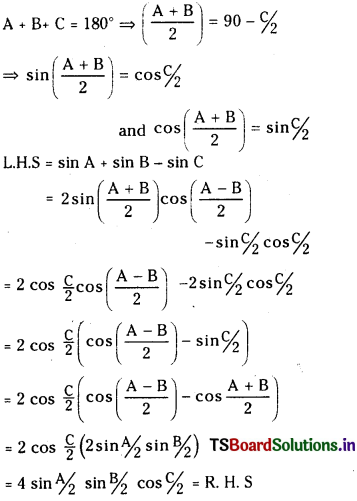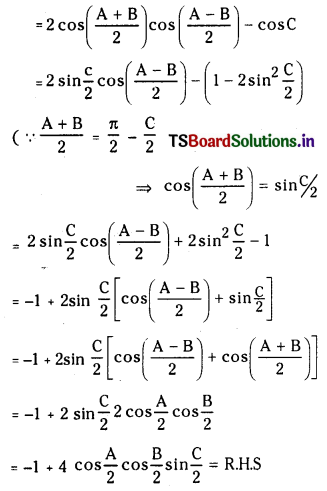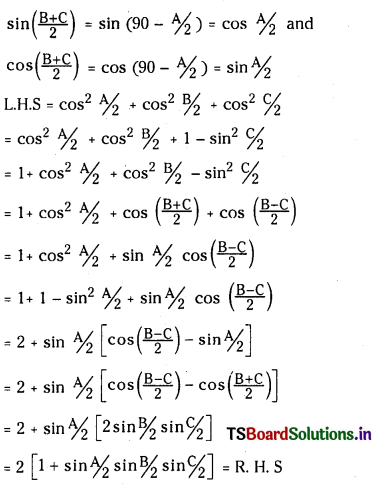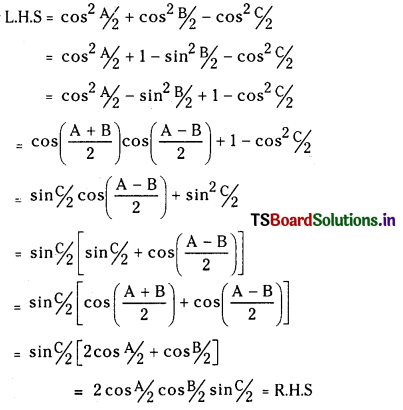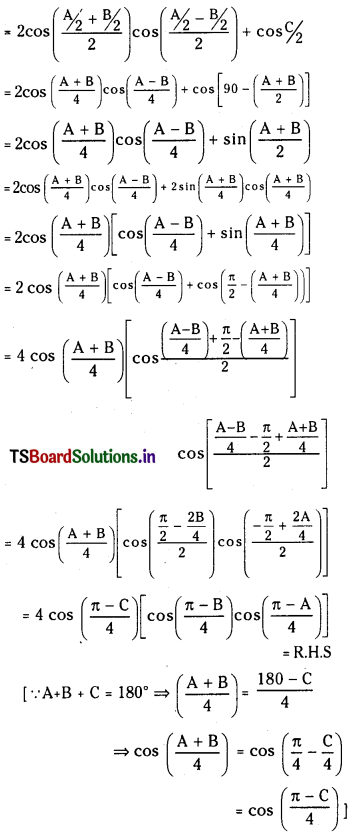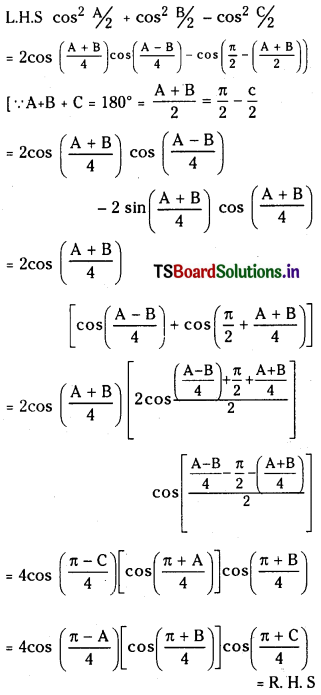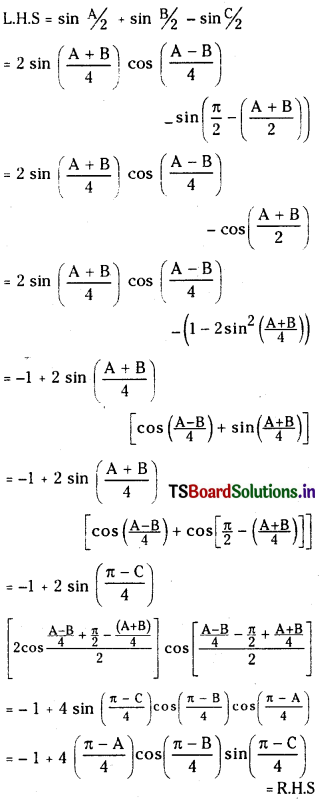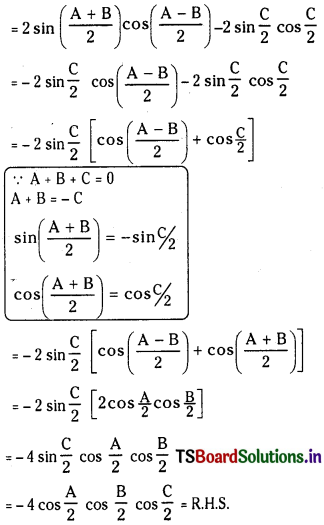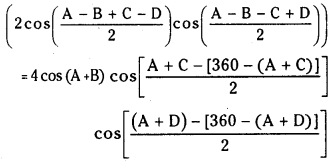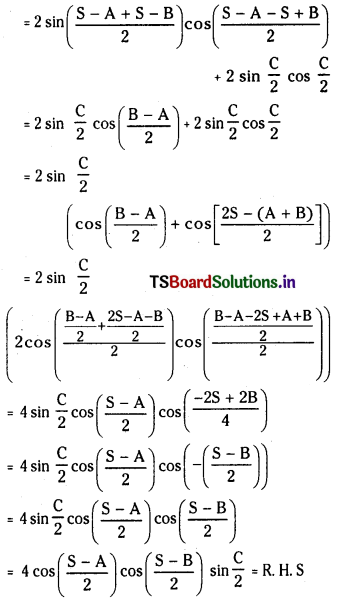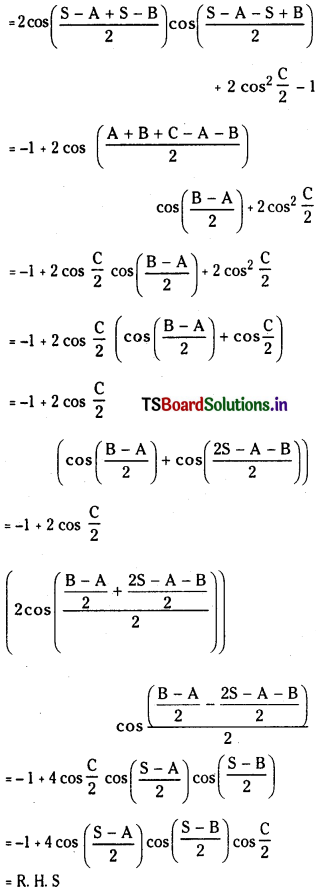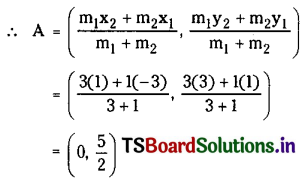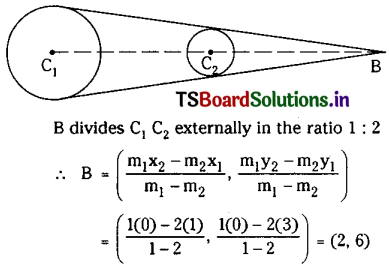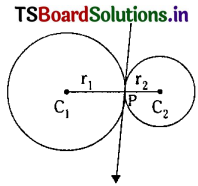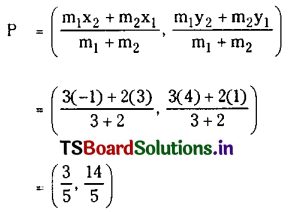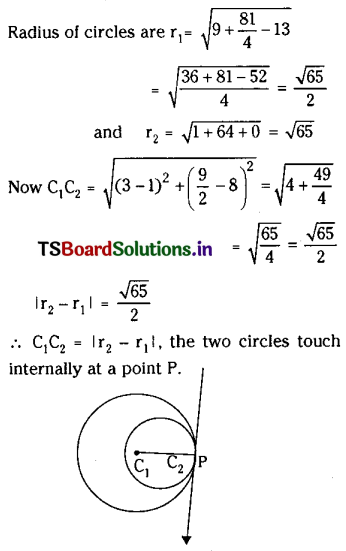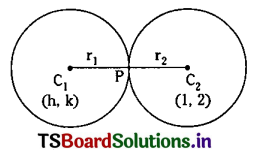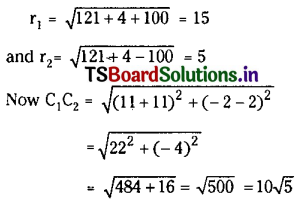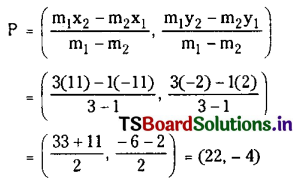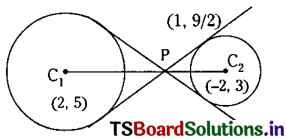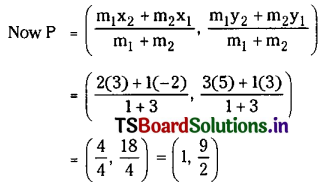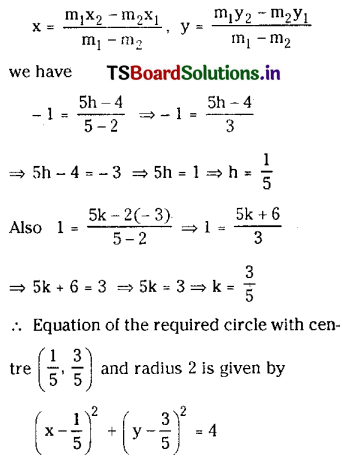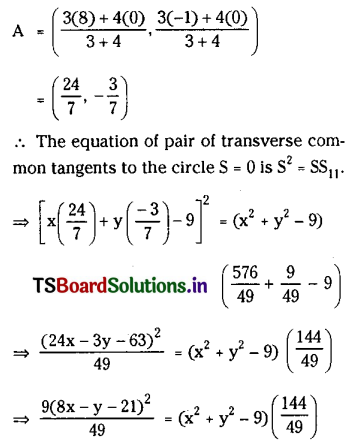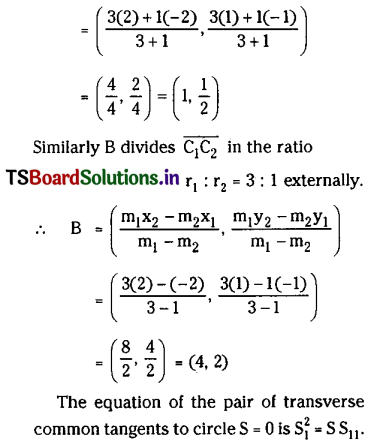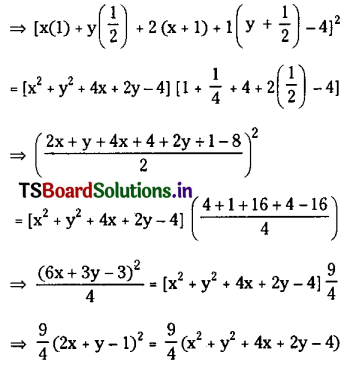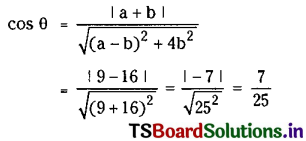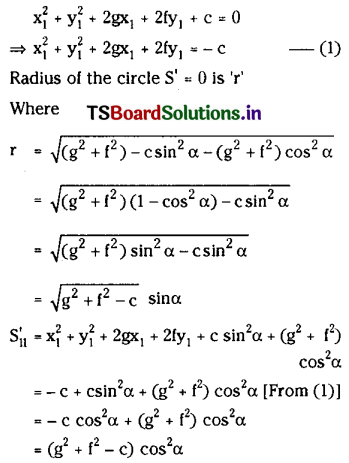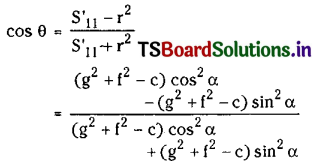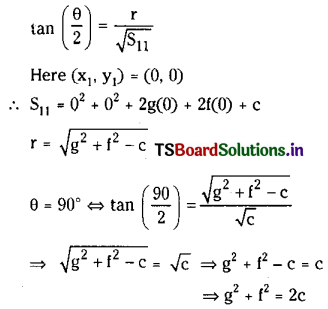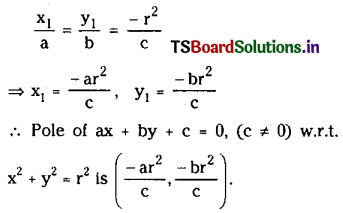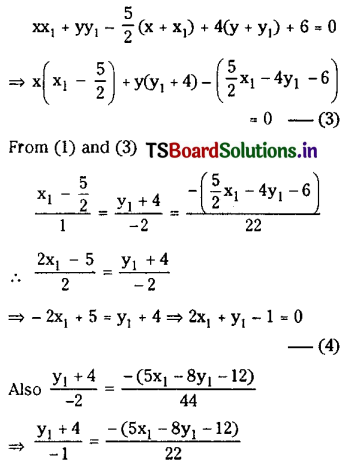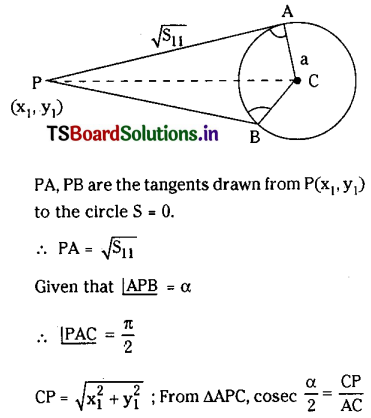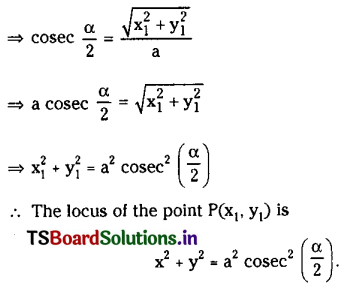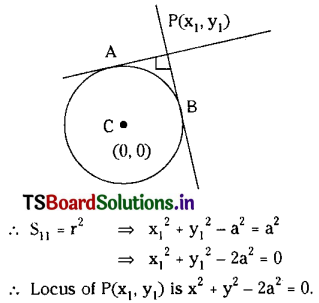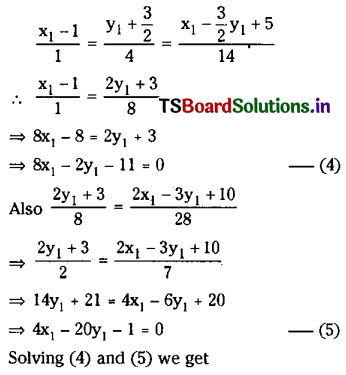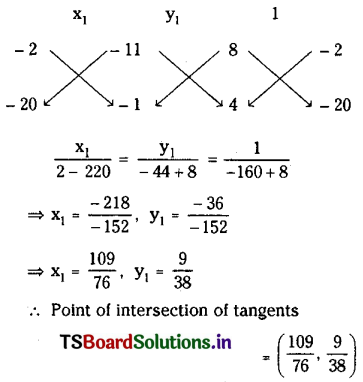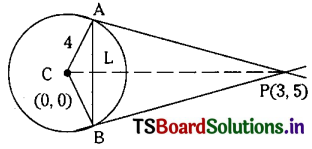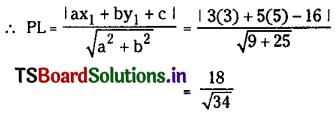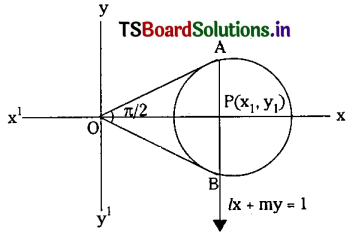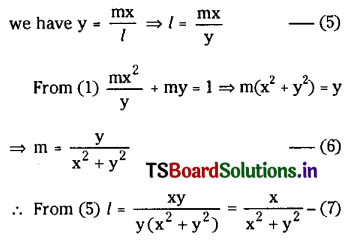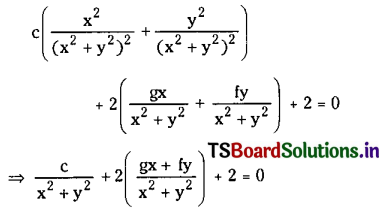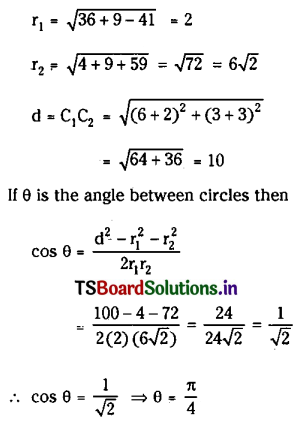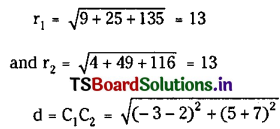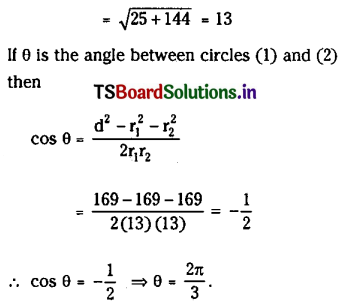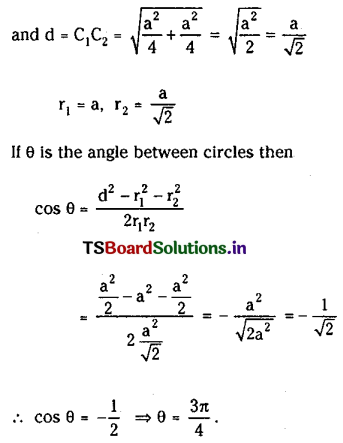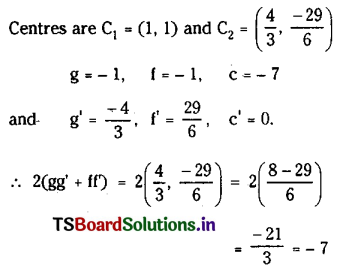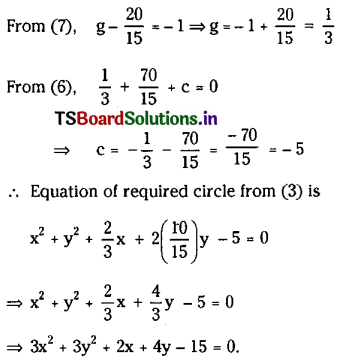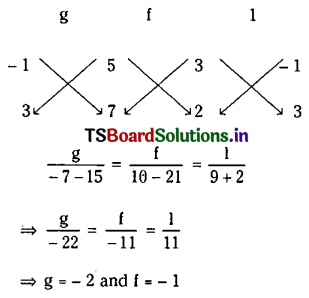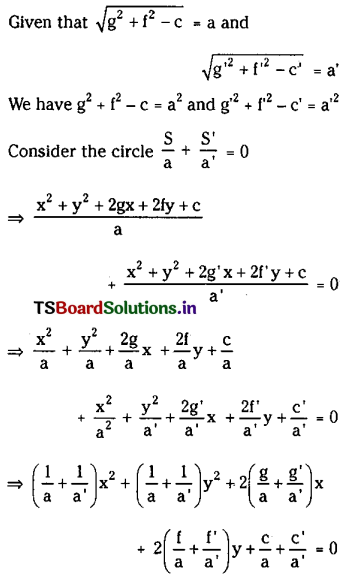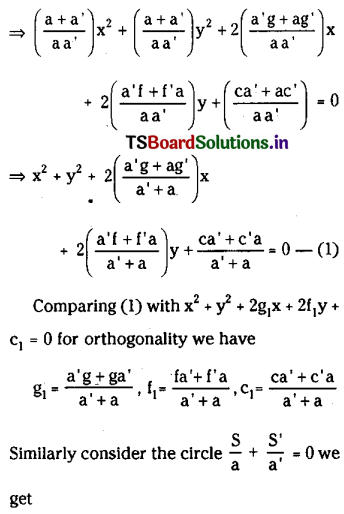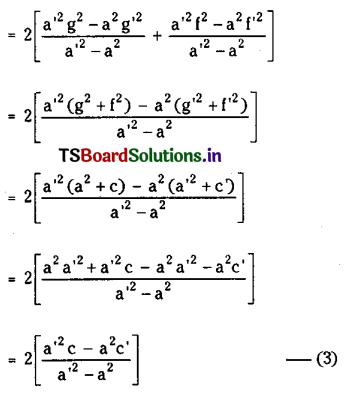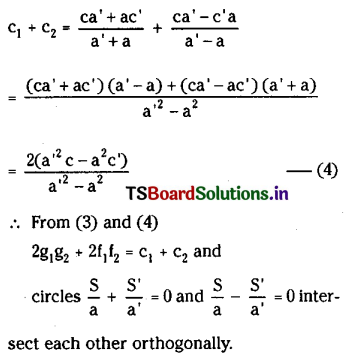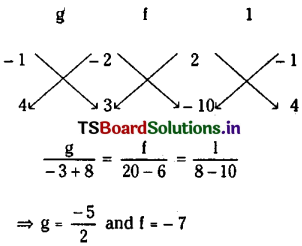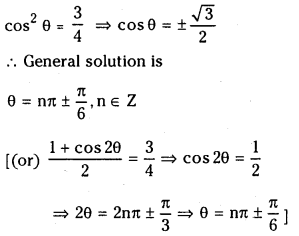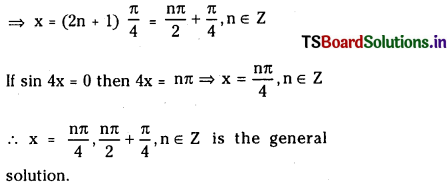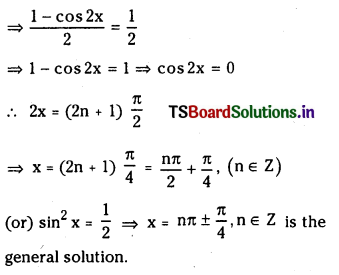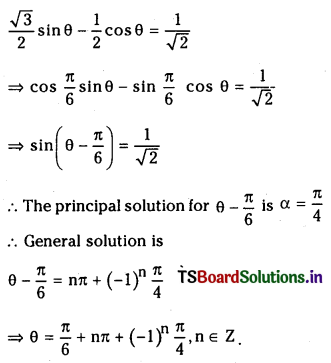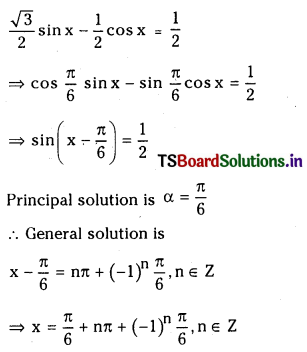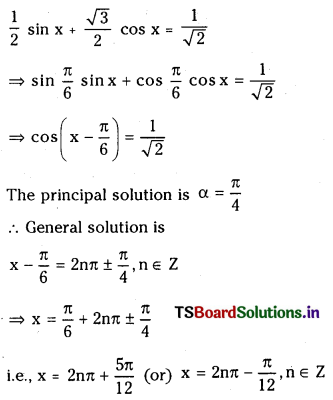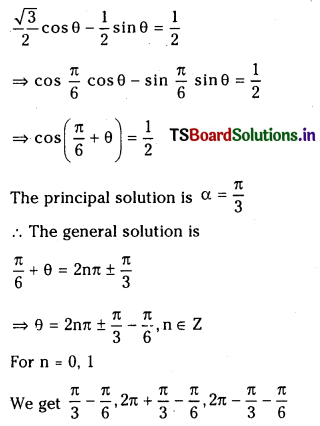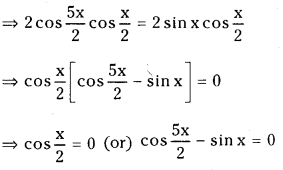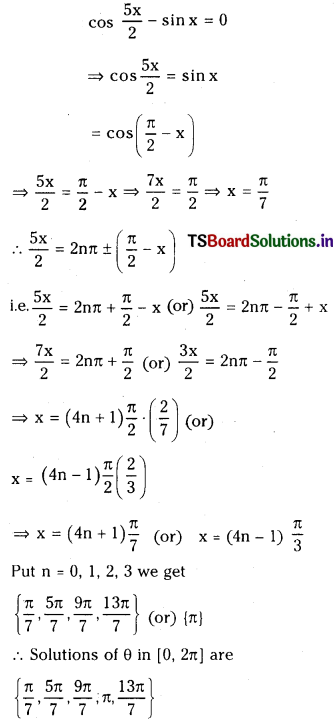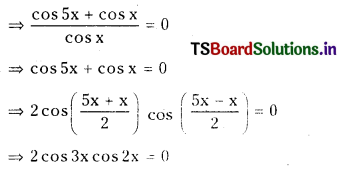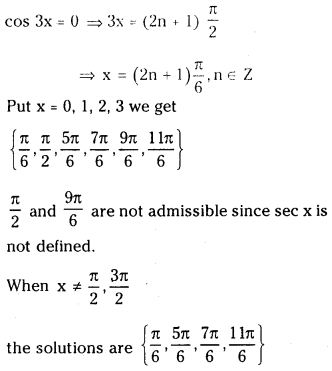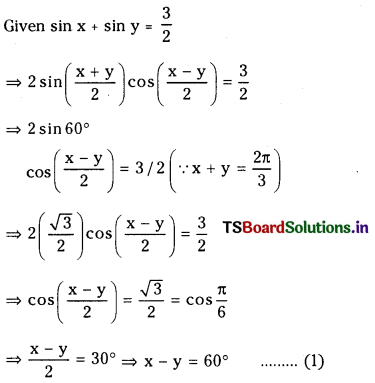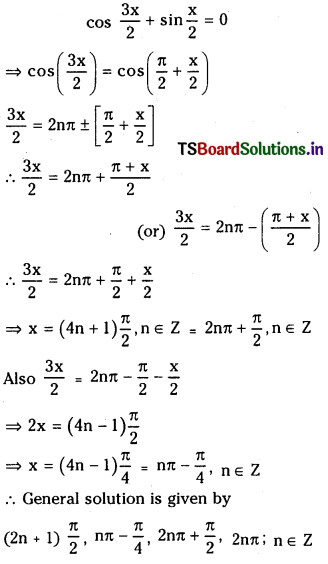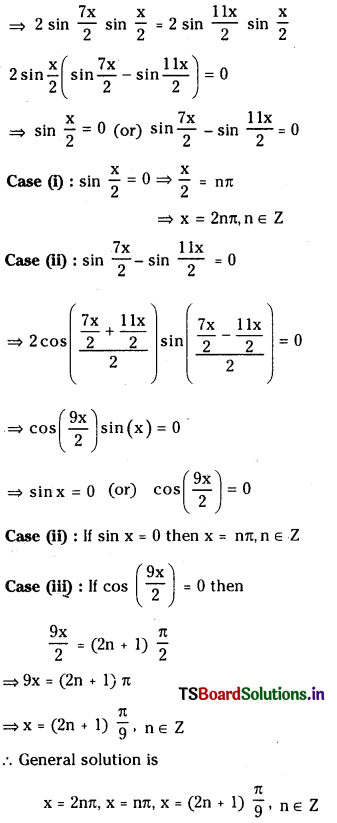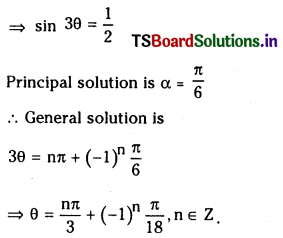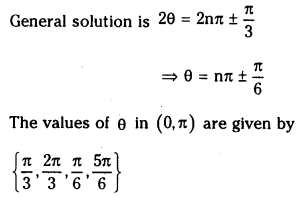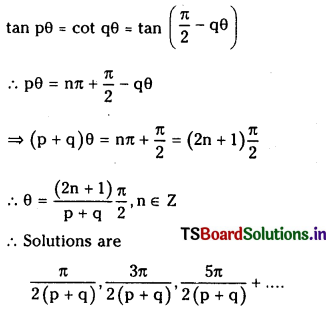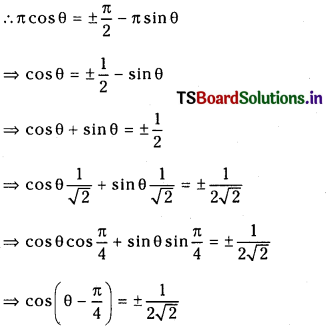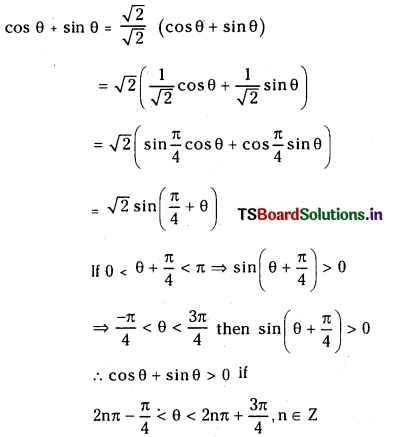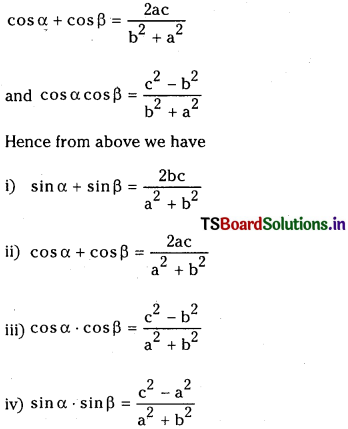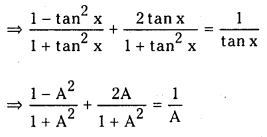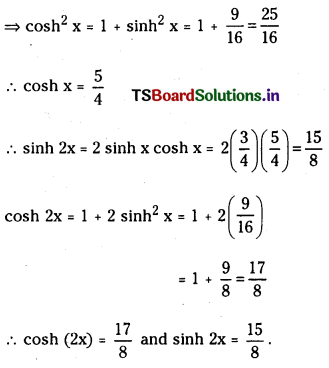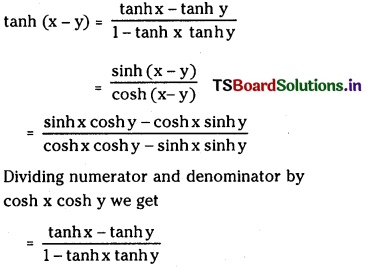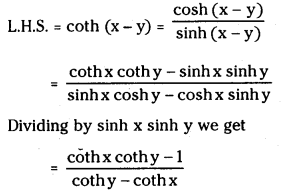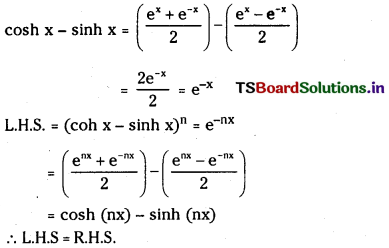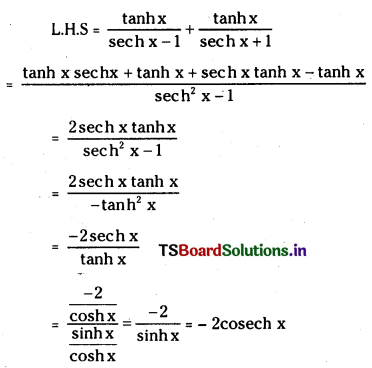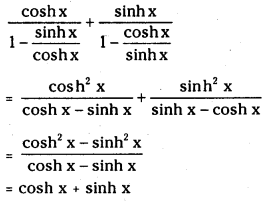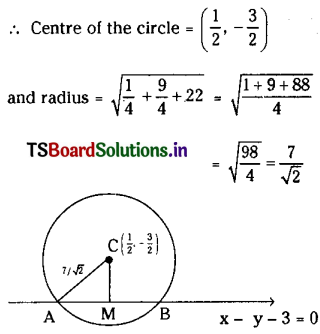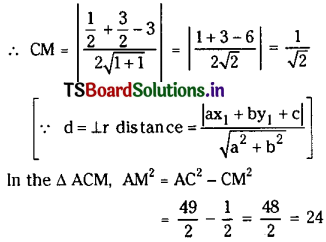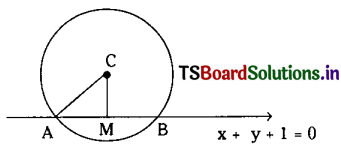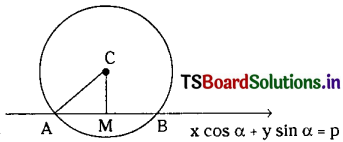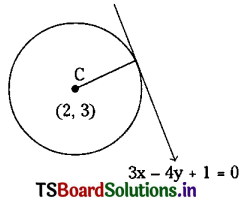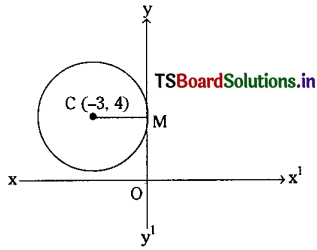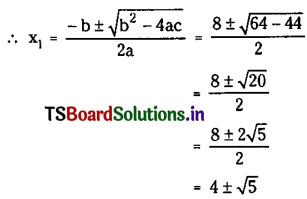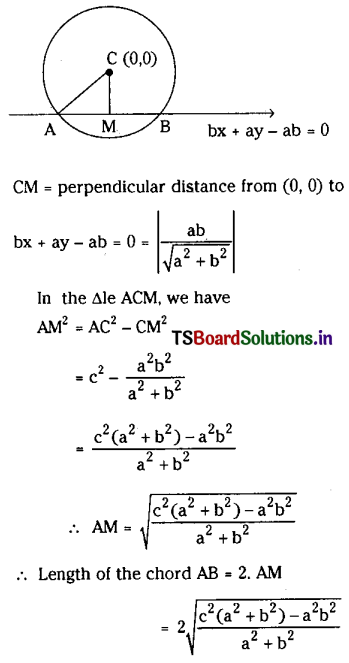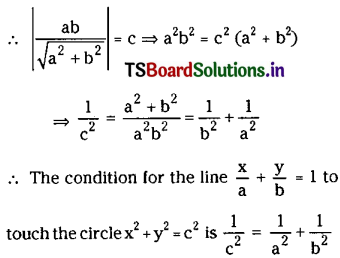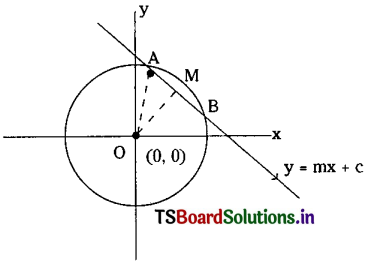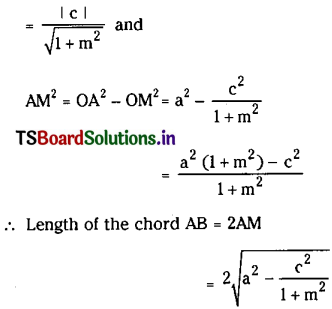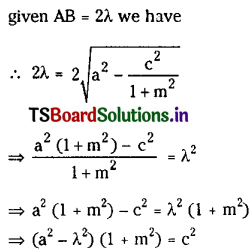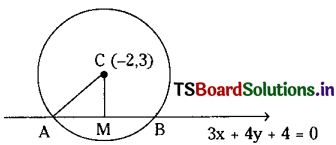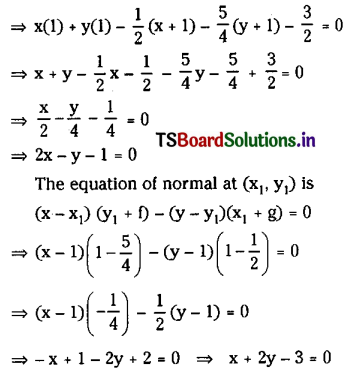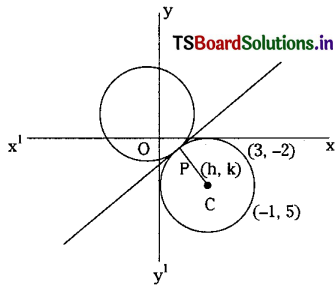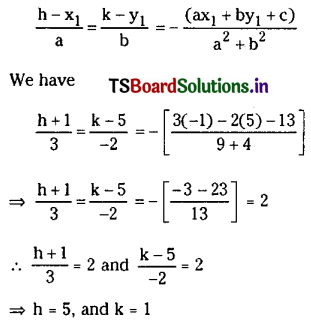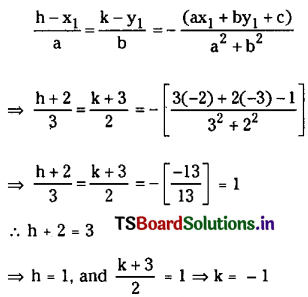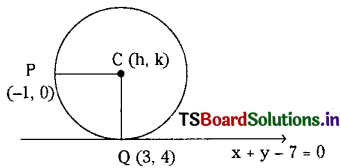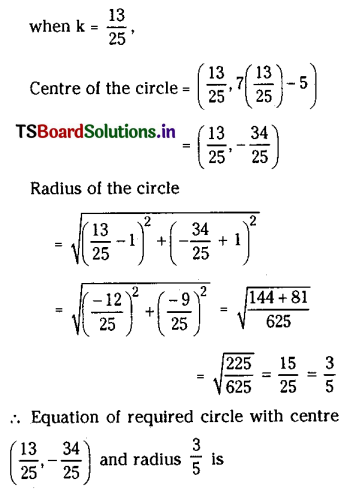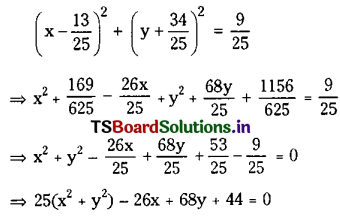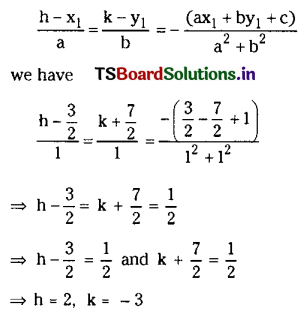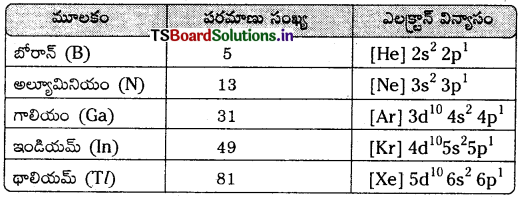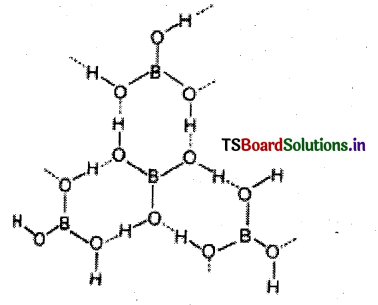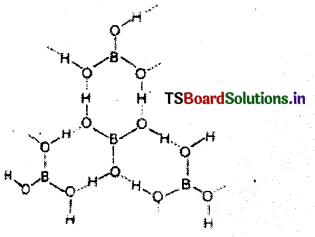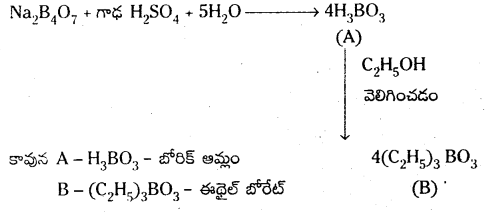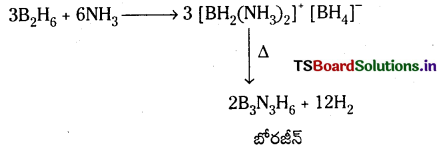Telangana TSBIE TS Inter 1st Year Chemistry Study Material 11th Lesson P బ్లాక్ మూలకాలు – 14వ గ్రూప్ Textbook Questions and Answers.
TS Inter 1st Year Chemistry Study Material 11th Lesson P బ్లాక్ మూలకాలు – 14వ గ్రూప్
అత్యంత లఘు సమాధాన ప్రశ్నలు
ప్రశ్న 1.
గ్రూపు 14 మూలకాల ఆక్సీకరణ స్థితులలో మార్పును చర్చించండి.
జవాబు:
14వ గ్రూపు మూలకాల బాహ్యతమ కర్పరంలో 4 ఎలక్ట్రానులు ఉన్నాయి. ఈ మూలకాలు కనబరచే సాధారణ ఆక్సీకరణ స్థితులు +4, + 2. కార్బన్ ఋణ ఆక్సీకరణ స్థితుల్ని కూడా చూపుతుంది.
+ 4 ఆక్సీకరణ స్థితిలో ఉన్న సమ్మేళనాలు సమయోజనీయ స్వభావం కలవిగా ఉంటాయి. భారతర మూలకాలలో +2 ఆక్సీకరణ స్థితిని చూపే ప్రవృత్తి పెరిగే క్రమం Ge < Sn < Pb. కార్బన్, సిలికాన్లు తరచుగా +4 ఆక్సీకరణ స్థితిని చూపుతాయి. జెర్మేనియం స్థిర సమ్మేళనాలను +4 స్థితిలో ఏర్పరుస్తుంది. టిన్ రెండు (+2, +4) ఆక్సీకరణ. స్థితులలోను సమ్మేళనాలను ఏర్పరుస్తుంది. లెడ్ సమ్మేళనాలు +2 స్థితిలో స్థిరమైనది.
ప్రశ్న 2.
క్రింది సమ్మేళనాలు నీటితో ఎలా ప్రవర్తిస్తాయి.
a) BCl3
b) CCl4
జవాబు:
a) BCl3 నీటితో చర్య పొంది H3BO3 ను ఏర్పరుస్తుంది.
BCl3 + 3 H2O → H3BO3 + 3HCl
b) CCl4 నీటితో చర్య పొందదు. నీటిలో కరుగదు. వేరే ప్రావస్థగా వుంటుంది.

ప్రశ్న 3.
BCl3, SiCl4 ఎలక్ట్రాన్ కొరత ఉన్న సమ్మేళనాలా ? వివరించండి.
జవాబు:
BCl3 లో బోరాన్ బాహ్య కర్పరంలో ఎలక్ట్రాన్ అష్టకం లేదు. కనుక అది ఎలక్ట్రాన్ కొరత గల సమ్మేళనం.
SiCl4 లోని Si కు బాహ్య కర్పరంలో ఎలక్ట్రాన్ అష్టకం ఉన్నది. అది ఎలక్ట్రాన్ కొరత గల సమ్మేళనం కాదు.
ప్రశ్న 4.
క్రింది వాటిలో కార్బన్ సంకరీకరణాన్ని సూచించండి.
a) C\(\mathrm{O}_3^{-2}\)
b) వజ్రం
c) గ్రాఫైట్
d) పుల్లరీన్
జవాబు:
a) C\(\mathrm{O}_3^{-2}\) : …….. sp2 సంకరీకరణం
b) వజ్రం : ………… sp3 సంకరీకరణం
c) గ్రాఫైట్ : ……… sp2 సంకరీకరణం
d) పుల్లరీన్ : …….. sp2 సంకరీకరణం
ప్రశ్న 5.
CO ఎందుకు విషపూరితమైనది ? (March 2013)
జవాబు:
CO విషపూరితమైనది. అది రక్తంలోని హిమోగ్లోబిన్ తో కలిసి స్థిరమైన సంక్లిష్టం ఏర్పరుస్తుంది. అందువల్ల హీమోగ్లోబిన్

కార్బాక్సీ హిమోగ్లోబిన్ ఆక్సీహిమోగ్లోబిన్ కన్నా 300 రెట్లు అధిక స్థిరమైనది.
ప్రశ్న 6.
రూపాంతర (allotropy) అంటే ఏమిటి ? స్పటిక రూపంలోని కార్బన్ భిన్న రూపాంతరాలను తెలపండి. (March 2013)
జవాబు:
ఒకే మూలకం భిన్న భౌతిక రూపాలలో లభించుటను రూపాంతరత అంటారు.
కార్బన్ మూడు స్ఫటిక రూపాంతరాలలో లభిస్తోంది. అవి వజ్రం, గ్రాఫైట్, ఫుల్లరిన్.
ప్రశ్న 7.
కింది ఆక్సెడులను తటస్థ, ఆమ్ల, క్షార, ద్విస్వభావం గల వాటిగా వర్గీకరించండి.
a) CO
b) B2O3
c) SiO2
d) CO2
e) Al2O3
f) PbO2
g) Tl2O3
జవాబు:
a) CO – తటస్థ
b) B2O3 – ఆమ్ల
c) SiO2 – ఆమ్ల
d) CO2 – ఆమ్ల
e) Al2O3 – ద్విస్వభావ
f) PbO2 – ద్విస్వభావ
g) Tl2O3 – క్షార
e) Al2O3 – ద్విస్వభావ
f) PbO2 – ద్విస్వభావ
g) Tl2O3 – క్షార

ప్రశ్న 8.
మనిషి (కృత్రిమంగా) తయారుచేసిన ఏవైనా రెండు సిలికేట్ల పేర్లు రాయండి.
జవాబు:
- గాజు
- సిమెంట
ప్రశ్న 9.
గ్రూపు 14 మూలకాల బాహ్య ఎలక్ట్రాన్ విన్యాసాన్ని రాయండి.
జవాబు:
గ్రూపు 14 మూలకాలు కార్బన్ (C); సిలికాన్ (Si); జెర్మేనియం (Ge); టిన్ (Sn) మరియు లెడ్ (Pb).
వాటి ఎలక్ట్రాన్ విన్యాసాలు :
కార్బన్ : 1s22s22p2 (Z = 6)
సిలికాన్ : 1s22s22p63s23p2 (Z = 14)
జెర్మేనియం : 1s22s22p63s23p63d104s24p2 (Z = 32)
టిన్ : 1s22s22p63s23p63d104s24p64d105s25p2 (Z = 50)
లెడ్ : 1s22s22p63s23p63d104s24p64d104f145s25p65d106s26p2 (Z = 82)
గ్రూపు 14 మూలకాల సాధారణ ఎలక్ట్రాన్ విన్యాసం ns2np2.
ప్రశ్న 10.
గ్రాఫైట్ కందెనలాగా ఎట్లా పనిచేస్తుంది ?
జవాబు:
గ్రాఫైట్ ద్వి జ్యామితీయ పొరల నిర్మాణం కలిగి ఉంటుంది. అంతేగాక ఈ పొరలు ఒకదానిపై ఒకటి జారుతూ ఉంటాయి. అందుకనే గ్రాఫైట్ కందెనగా పనిచేస్తుంది.
ప్రశ్న 11.
గ్రాఫైట్ మంచి వాహకం – వివరించండి.
జవాబు:
గ్రాఫైట్ ప్రతి కార్బన్ పరమాణువు వద్ద సంకరీకరణంలో పాల్గొనని p – ఆర్బిటాల్లో ఎలక్ట్రాన్ ఉంది. దీనినే స్వేచ్ఛా ఎలక్ట్రాన్ అంటారు. ఒక్కొక్క కార్బన్ పరమాణువు మూడు ఆసన్న కార్బన్ sp2 సంకర ఆర్బిటాల్లను ఉపయోగించుకొని మూడు సిగ్మా బంధాలను ఏర్పరుస్తుంది. నాలుగవ ఎలక్ట్రాన్ π బంధాన్ని ఏర్పరుస్తుంది. ఈ ఎలక్ట్రాన్లు మొత్తం పొర అస్థానీకృతం అవుతాయి. ఈ ఎలక్ట్రానులు చలనంలో ఉంటాయి. అందువల్ల గ్రాఫైట్ మంచి విద్యుద్వాహకం.
ప్రశ్న 12.
సిలికా నిర్మాణాన్ని వివరించండి.
జవాబు:
సిలికాన్ డై ఆక్సైడును సిలికా అంటారు. సిలికాన్ డై ఆక్సైడ్ సమయోజనీయ, త్రిమితీయ అల్లిక గల ఘనం. ఇందులో సిలికాన్ పరమాణువు సమయోజనీయ బంధంతో టెట్రా హెడ్రల్ రీతిలో నాలుగు ఆక్సిజన్ పరమాణువులతో కలిసి ఉంటుంది. ప్రతి ఆక్సిజన్ పరమాణువు ఇంకొక సిలికాన్ పరమాణువుతో సమయోజనీయ బంధంతో ఉంటుంది. మొత్తం స్ఫటికాన్ని బృహత్ అణువుగా భావించవచ్చు.

ప్రశ్న 13.
“సంశ్లేషణ వాయువు” అంటే ఏమిటి ?
జవాబు:
వేడిగానున్న కోక్ మీదకు నీటి ఆవిరిని పంపడం ద్వారా వ్యాపార పద్ధతిలో CO, H2 ల మిశ్రమాన్ని తయారుచేస్తారు. ఏర్పడిన CO, H2 ల మిశ్రమాన్ని సంశ్లేషణ వాయువు అంటారు.
ప్రశ్న 14.
“ప్రొడ్యూసర్ వాయువు” అంటే ఏమిటి ?
జవాబు:
CO, N2 ల మిశ్రమాన్ని ప్రొడ్యూసర్ గ్యాస్ అంటారు. దీని సంఘటనం CO = 33%, N2 = 64%, CO2 మరియు
H2 = 2.5%
ప్రశ్న 15.
వజ్రానికి అధిక ద్రవీభవన ఉష్ణోగ్రత ఉంటుంది. వివరించండి.
జవాబు:
వజ్రం త్రిజ్యామితీయ బృహదణు నిర్మాణం కలిగి ఉంటుంది. ప్రతి కార్బన్ sp3 సంకరీకరణం చెందుతుంది. ప్రతి కార్బన్ నాలుగు ఇతర కార్బన్ పరమాణువులతో sp3 సంకర ఆర్బిటాళ్ళతో బంధాలను ఏర్పరుస్తుంది. ఈ నిర్మాణం ప్రాదేశికంగా వ్యాపించి కార్బన్ పరమాణువులతో దృఢమైన త్రిమితీయ అల్లికను ఏర్పరుస్తుంది. ఇలా వ్యాపించి ఉన్న సమయోజనీయ బంధాలను విచ్ఛిన్నం చేయడం చాలా శక్తితో కూడుకున్న పని. అందువల్ల వజ్రానికి అధిక ద్రవీభవన ఉష్ణోగ్రత ఉంటుంది.
ప్రశ్న 16.
కిరణజన్య సంయోగ క్రియలో CO2 పాత్ర ఏమిటి ?
జవాబు:
కిరణజన్య సంయోగక్రియ ద్వారా పచ్చటి చెట్లు వాతావరణంలోని కార్బన్ డై ఆక్సైడ్ను గ్లూకోజ్ వంటి కార్బోహైడ్రేటులుగా మారుస్తాయి.

ప్రశ్న 17.
హరిత గృహ ప్రభావాన్ని ఏ విధంగా CO2 పెంచుతుంది ?
జవాబు:
శిలాజ ఇంధనాల దహనం పెరగడం, సిమెంట్ను ఉత్పత్తి చేయడానికి ఇటీవలి కాలంలో లైమ్ స్టోన్ వినియోగం బాగా పెరగడం వల్ల వాతావరణంలో CO2 భాగం పెరుగుతోంది. దీనివల్ల హరితగృహ ఫలితం పెరుగుతోంది.
ప్రశ్న 18.
సిలికోన్లు అంటే ఏమిటి ?
జవాబు:
సిలికోన్లు ఆర్గానో సిలికాన్ సమ్మేళనాలు. వీటిలో సిలికాన్ కు ఆక్సిజన్, కార్బన్లు బలంగా బంధింపబడి ఉంటాయి.

ప్రశ్న 19.
సిలికోన్ల ఉపయోగాలు వ్రాయండి.
జవాబు:
సిలికోన్ల ఉపయోగాలు :
- వాటర్ ఫ్రూఫ్ బట్టలు, కాగితాలను తయారుచేయడానికి వాడతారు.
- సిలికోన్ రబ్బరు ఉత్తమ విద్యున్నిరోధకం. అందువల్ల ఎలక్ట్రికల్ మోటార్లలో ఉపయోగిస్తారు.
- వీటికి రసాయన జడత్వం ఉన్నది. అందువలన అధిక ఉష్ణోగ్రతలను తట్టుకుంటాయి. ఈ కారణంగా వాటిని పెయింట్లలోనూ, పింగాణీలలోనూ ఉపయోగిస్తారు.
- ద్రవ సిలికోన్ల స్నిగ్ధత ఉష్ణోగ్రతతో మారదు. -40°C వద్ద కూడ ఇవి గడ్డ కట్టవు. అందువలన వీటిని విమానాలలో కందెనగా వాడతారు.
- సిలికోన్ నూనెలు అధిక స్థిరత్వం కలిగి ఉంటాయి. వేడిచేసినా కూడా ఆవిరి చెందవు. అందువలన వాటిని అధిక ఉష్ణోగ్రతల వద్ద ఆయిల్ బాథ్ మరియు అధిక శూన్యత పంపులలోనూ వాడతారు.
ఈ విధంగా ఆధునిక యుగంలో సిలికోన్లను అన్ని రంగాలలో వాడతారు.
ప్రశ్న 20.
తగరం (టిన్) మీద నీటి ప్రభావం ఏమిటి ?
జవాబు:
టిన్ నీటి ఆవిరిని వియోగం చెందించి డై ఆక్సైడు, డై హైడ్రోజన్లను ఏర్పరుస్తుంది.


ప్రశ్న 21.
SiCl4 గురించి వ్రాయండి.
జవాబు:
సిలికాన్ టెట్రా క్లోరైడును సిలికాన్పై క్లోరిన్ చర్యవల్ల ఏర్పడుతుంది.
Si + 2Cl2 – SiCl4
SiCl4 బాష్పశీలి ద్రవం. నీటి అణువు ఇచ్చే ఒంటరి ఎలక్ట్రాన్ జంటను Si లోని d ఆర్బిటాల్ స్వీకరించి Si(OH)4 ఏర్పడుతుంది.
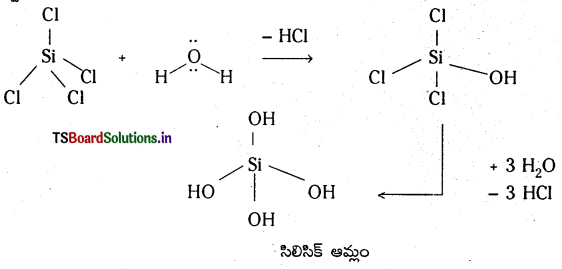
ప్రశ్న 22.
CO2 వాయువు కానీ SiO2 ఘనపదార్థం – వివరించండి.
జవాబు:
సిలికాన్ డై ఆక్సైడ్ త్రిమితీయ బృహదణు నిర్మాణం కలిగి ఉంటుంది. ప్రతి సిలికాన్ పరమాణువు నాలుగు ఆక్సిజన్ పరమాణువులతో చతుర్ముఖీయంగా నాలుగు సమయోజనీయ బంధాలతో బంధింపబడి ఉంటుంది. అందువలన SiO2 ఘనపదార్థంగా ఉంటుంది.
CO2 రేఖీయ అణువు. ఈ అణువులు విడివిడిగా ఉంటాయి. ఈ అణువుల మధ్య వాన్ డర్వాల్ బలాలు ఉంటాయి. అందువలన CO2 వాయువుగా ఉంటుంది.
ప్రశ్న 23.
ZSM – 5 ఉపయోగం వ్రాయండి.
జవాబు:
జియొలైట్లను ఉత్ప్రేరకాలుగా వాడతారు. ZSM-5 అనే జియోలైట్ను ఆల్కహాల్లను నేరుగా గాసోలిన్ మార్చడానికి ఉపయోగిస్తారు.
ప్రశ్న 24.
పొడి మంచు ఉపయోగం ఏమిటి ?
జవాబు:
ఘన CO2 ను పొడి మంచు అంటారు. ఐస్క్రీమ్, అతిశీతలమైన ఆహారపదార్థాల కోసం ప్రశీతకంగా ఉ పయోగిస్తున్నారు. బరువైనదీ, దహనానికి దోహదపడేదీ కనుక దీనిని మంటలను ఆర్పడానికి వాడతారు.
ప్రశ్న 25.
జలవాయువు (Water gas) ను ఎలా తయారుచేస్తారు ?
జవాబు:
వేడిగా నున్న కోక్ మీదకు నీటి ఆవిరిని పంపుట ద్వారా వ్యాపార పద్ధతిలో జలవాయువును తయారుచేస్తారు.

ప్రశ్న 26.
ప్రొడ్యూసర్ వాయువును ఎలా తయారుచేస్తారు ?
జవాబు:
కొలిమిని కోక్తో నింపి, దాని అడుగు భాగం నుండి వేడి గాలిని పంపుతారు. మొదట CO2 వాయువు ఏర్పడుతుంది.
CO2 కోల్ బెడ్ మీదుగా ప్రయాణించి CO గా క్షయకరణం చెందుతుంది.
CO, N2 ల మిశ్రమం బయటకు వస్తుంది.
C + O2 → CO2
C + O2 → 2CO
ప్రశ్న 27.
గ్రాఫైట్లో C − C బంధ దూరం, వజ్రంలో C – C బంధ దూరం కంటే తక్కువ – వివరించండి.
జవాబు:
గ్రాఫైట్ కార్బన్ C – C బంధ దూరం 141.5 pm గ్రాఫైట్లో కార్బన్ sp2 సంకరీకరణం చెంది ఉంటుంది. అందువల్ల మూడు సిగ్మా బంధాలను ఏర్పరుస్తుంది. నాల్గవ ఎలక్ట్రాన్ 7 బంధాన్ని ఏర్పరుస్తుంది. ద్విబంధ స్వభావం వల్ల C – C బంధ దూరం తక్కువ.
వజ్రంలో కార్బన్ sp3 ఆర్బిటాళ్ళతో C – C ఏకబంధాలను మాత్రమే ఏర్పరుస్తుంది. అందువల్ల C – C బంధ దూరం 154 pm.
ప్రశ్న 28.
వజ్రాన్ని అమూల్యమైన రాయిగా వాడతారు – వివరించండి.
జవాబు:
వజ్రానికి వక్రీభవన గుణకం గరిష్ఠంగా 2.45 ఉన్నది. కాంతి పతనమైనపుడు అధిక వక్రీభవన గుణకం వల్ల సంపూర్ణాంతర పరావర్తనం జరుగుతుంది. అందువల్ల వజ్రం కాంతి పడినపుడు ప్రకాశిస్తుంది. అందువల్ల వజ్రాన్ని అమూల్య రాయిగా వాడతారు.
ప్రశ్న 29.
కార్బన్ సంయోజకత నాలుగు కంటే ఎక్కువ ఎప్పుడూ చూపించదు. కానీ ఆ కుటుంబంలో మిగతా మూలకాలు
సంయోజకత ఆరు వరకు చూపిస్తాయి – వివరించండి.
జవాబు:
కార్బన్ బాహ్య కర్పరం 2వ కర్పరం. దీనిలో d ఆర్బిటాళ్ళు ఉండవు. అందువల్ల బాహ్య కర్పరంలో నాలుగు ఎలక్ట్రానులను ఉపయోగించుకొని నాలుగు బంధాలను మాత్రమే ఏర్పరుస్తుంది. కావున కార్బన్ సంయోజకత నాలుగుకు మించదు. మిగిలిన 14వ గ్రూపు మూలకాలు బాహ్య స్థాయిలో ఖాళీ d ఆర్బిటాళ్ళు అందుబాటులో ఉన్నాయి. అందువల్ల అవి ఎలక్ట్రాన్ జంటలను స్వీకరించగలవు. అధిక సమన్వయ సంఖ్యను చూపించగలవు.
ప్రశ్న 30.
ప్రొడ్యూసర్ వాయువు, జల వాయువు కంటె తక్కువ సామర్థ్యం గల ఇంధనం – వివరించండి.
జవాబు:
ప్రొడ్యూసర్ వాయువులో 33% CO మరియు 65% N2 ఉన్నాయి. నైట్రోజన్ దహనశీలి కాదు. అందువల్ల దాని కెలోరిఫిక్ విలువ 5439 కి.జౌ./మీ3.
జలవాయువులో CO మరియు H2 లు దహనశీలి వాయువులు. అందువల్ల జలవాయువులో దహనం చెందగల వాయువుల శాతం ఎక్కువ. దాని కెలోరిఫిక్ విలువ 13,000 కి.జౌ./మీ3.
ప్రశ్న 31.
Si\(F_6^{-2}\) తెలుసు కాని SiC\(l_6^{-2}\) తెలియదు వివరించండి.
జవాబు:
- Si+ అయాన్ సైజు పరిమితి వల్ల దాని చుట్టూ ఆరు పెద్ద క్లోరైడు అయాన్లకు సరిపడినంత చోటు లేకపోవుట.
- క్లోరైడు అయాన్ ఒంటరి జంట, si4+ ల మధ్య అన్యోన్య చర్య బలహీనమైనది.
లఘు సమాధాన ప్రశ్నలు
ప్రశ్న 32.
నిర్మాణాల ఆధారంగా వజ్రం, గ్రాఫైట్ల ధర్మాలలో తేడాలను వివరించండి.
జవాబు:
గ్రాఫైట్ :
1) గ్రాఫైట్ మృదువుగా వుండి, జారుడు స్వభావం కలిగి ఉంటుంది. కందెనగా ఉపయోగించవచ్చు.
కారణం : గ్రాఫైట్ ని ప్రంతి కార్బన్ (0 సంకరీకరణం చగ్రాఫైట్ పొరల నిర్మాణం కలిగి ఉండి, ఆ పొరలు ఒకదానిపై ఒకటి బలహీన వాండర్ వాల్ బలాలచే బంధించబడి ఉంటాయి. అందువల్లనే, ఒత్తిడి కలుగచేసినపుడు ఆ పొరలు ఒకదానిపై ఒకటి జారుతాయి. అందువలననే గ్రాఫైట్ మృదువుగా ఉంటుంది. కందెనగా ఉపయోగిస్తారు.
2) గ్రాఫైట్ ఉత్తమ ఉష్ణ వాహకం.
కారణం : గ్రాఫైట్లో స్వేచ్ఛా ఎలక్ట్రాన్ ఉంది. అది π బంధాన్ని ఏర్పరుస్తుంది. ఈ ఎలక్ట్రానులు మొత్తం పొర అంతా అస్థానీకృతం అవుతాయి. ఈ ఎలక్ట్రానులు చలనంలో ఉంటాయి. అందువల్ల గ్రాఫైట్ మంచి విద్యుద్వాహకం.
వజ్రం :
1) వజ్రం కఠినంగా ఉండి అరగదీసే రాయిగా పనిచేస్తుంది.
కారణం : వజ్రంలోని ప్రతి కార్బన్ sp3 సంకరీకరణం చెంది వుంటుంది. ప్రతి కార్బన్ నాలుగు ఇతర కార్బన్లతో sp3 – sp3 అతిపాతాల ద్వారా బలమైన బంధాలను ఏర్పరచడం వల్ల త్రిమితీయ బృహదణు నిర్మాణాన్ని పొందుతుంది. ఈ బంధాలను ఛేదించుట కష్టం. అందువల్ల వజ్రం కఠినం.
2) వజ్రం ఉష్ణ వాహకం కాదు.
కారణం : వజ్రంలోని కార్బన్ల వద్ద స్వేచ్ఛా ఎలక్ట్రానులు లేవు.
డైమండ్ మరియు గ్రాఫైట్ మధ్య భేదాలు :
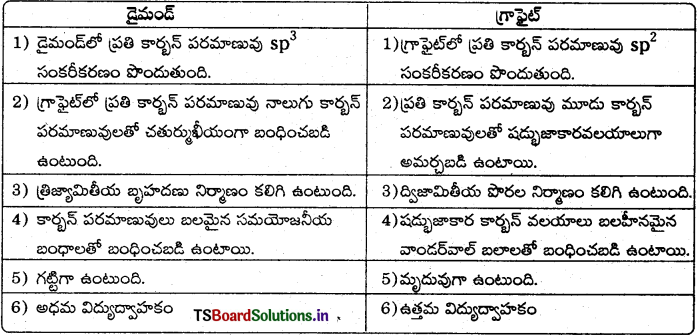
ప్రశ్న 33.
క్రింది వాటిని వివరించండి.
a) PbCl2, Cl2 తో చర్య జరిగి, PbCl4 ఇస్తుంది
b) PbCl4 ఉష్ణ అస్థిర పదార్ధం
c) లెడ్ PbI4 ను ఏర్పరచదు
జవాబు:
a) PbCl2 లో Pb + 2 ఆక్సీకరణ స్థితిలో ఉన్నది. Cl2 బలమైన ఆక్సీకారిణి. అందువల్ల అది Pb+2 ను Pb+4 గా
ఆక్సీకరణం చేస్తుంది. కనుక PbCl2 ను Cl2, PbCl4 గా ఆక్సీకరణం చేస్తుంది.
b) జడ ఎలక్ట్రాన్ జంట ప్రభావం కారణంగా Pb++, Pb++++ కన్నా స్థిరమైనది. అంటే PbCl2, PbCl4 కన్నా స్థిరమైనది. అందువల్ల వేడి చేసినపుడు PbCl4 ను వేడి చేస్తే Cl2 ను కోల్పోయి PbCl2 గా మారుతుంది.
c) Pb+4 జడ ఎలక్ట్రాన్ జంట ప్రభావం కారణంగా అస్థిరం. అందువల్ల Pb+4 మంచి ఆక్సీకారిణి. I– మంచి క్షయకారిణి. అందువల్ల Pb+4 ను Pb+2 గా క్షయీకరిస్తుంది. అందువల్ల PbI4 ఏర్పడదు.

ప్రశ్న 34.
క్రింది వాటిని వివరించండి.
a) సిలికాన్ను మిథైల్ క్లోరైడ్తో కాపర్ సమక్షంలో అత్యధిక ఉష్ణోగ్రత వద్ద వేడి చేయబడింది.
b) SiO2 ను HF తో చర్య జరపడం
c) గ్రాఫైట్ కందెనగా పనిచేస్తుంది
d) వజ్రం అపఘర్షకంగా ఉంటుంది.
జవాబు:
a) 573K వద్ద కాపర్ ఉత్ప్రేరకం సమక్షంలో మిథైల్ క్లోరైడ్ను సిలికాన్ పైకి పంపితే అనేక రకాలైన మిథైల్ ప్రతిక్షేపిత క్లోరో సైలేనులు, Me SiCl3, Me2, SiCl2, Me3, SiCl చాలా తక్కువ పరిమాణంలో Me4 Si ఏర్పడతాయి.

b) SiOn ను HF తో చర్య జరపడం
SiO2 + 4HF → SiF4 + 2H2O
సిలికా HF లో కరిగి Silicon టెట్రా ఫ్లోరైడ్ను ఏర్పరుస్తుంది.
c) గ్రాఫైట్ ద్విజ్యామితీయ పొరల నిర్మాణం కలిగి ఉంటుంది. అంతేగాక, ఈ పొరలు ఒకదానిపై ఒకటి జారుతూ ఉంటాయి. అందుకనే గ్రాఫైట్ కందెనగా పనిచేస్తుంది.
d) వజ్రం త్రిజ్యామితీయ బృహదణు నిర్మాణం కలిగి ఉంటుంది. దీనిలో ప్రతి కార్బన్ పరమాణువు నాలుగు వేరు వేరు కార్బన్లతో బలమైన ఏకబంధాలతో బంధింపబడి ఉంటుంది. అందువల్ల వజ్రం కఠిన పదార్థం. అందువల్ల అపఘర్షకంగా ఉంటుంది.
ప్రశ్న 35.
మీరేమి అర్ధం చేసుకొన్నారు :
a) రూపాంతరత
b) జడజంట ప్రభావం
c) శృంఖలత్వం (catination)
జవాబు:
a) రూపాంతరత : ఒకే మూలకం రెండు లేక అంతకన్నా ఎక్కువ భౌతిక రూపాలలో లభించడాన్ని రూపాంతరత అంటారు.
డైమండ్, గ్రాఫైట్లు, కార్బన్ స్ఫాటిక రూపాంతరాలు. కోక్, కోల్, అస్ఫాటిక రూపాంతరాలు.
b) జడజంట ప్రభావం : బాహ్య కర్పరంలో ns2 ఎలక్ట్రాన్ జంట. బంధాలు ఏర్పరచడంలో పాల్గొనకపోవడాన్ని జడజంట ప్రభావం అంటారు. ఈ ప్రభావం కారణంగా తక్కువ విలువ గల ఆక్సీకరణ స్థితి అధిక ఆక్సీకరణ స్థితి కన్నా స్థిరమైనదిగా ఉంటుంది. ఒక గ్రూపు మూలకాలలో పైనుండి క్రిందకు, అల్ప ఆక్సీకరణ స్థితి స్థిరత్వం
పెరుగుతుంది.
13వ గ్రూపు మూలకాలలో +3 సాధారణ ఆక్సీకరణ స్థితి కాగా Tl లో +1 స్థితి స్థిరమైనది. అదే విధంగా 14వ గ్రూపు మూలకాలలో +4 సాధారణ ఆక్సీకరణ స్థితి కాగా Pb లో +2 స్థితి స్థిరమైనది.
c) శృంఖలత్వం :
ఏదేని మూలక పరమాణువులు తమలో తాము గొలుసుకట్టుగా ఏర్పడే స్వభావాన్ని శృంఖలత్వం అంటారు. ఈ ధర్మం కార్బన్కు అధికం. అందువల్ల కార్బన్ గొలుసులు, వలయాలు ఏర్పడతాయి.
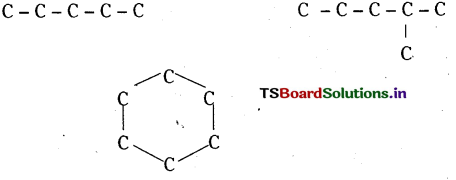
ప్రశ్న 36.
సిలికోన్ల తయారీలో RSiCl3 ప్రారంభ పదార్థంగా వాడితే తయారైన క్రియాజన్యాల నిర్మాణాలను రాయండి.
జవాబు:
R SiCl3 + 3H2O → R Si (OH)3
జలవిశ్లేషణ ఉత్పన్నం సంఘననం చెందితే త్రిజ్యామితీయ సిలికోన్ ఏర్పడుతుంది.
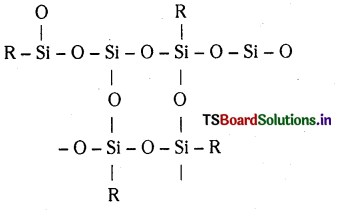
ప్రశ్న 37.
జియొలైట్ల మీద సంక్షిప్తంగా రాయండి.
జవాబు:
అల్యూమినియం సిలికేటులను జియొలైట్లు అంటారు. త్రిమితీయంగా అల్లిక గల సిలికాన్ డై ఆక్సైడ్లో కొన్ని సిలికాన్ పరమాణువులను అల్యూమినియం పరమాణువులు స్థానభ్రంశం చేస్తే అల్యూమినియం సిలికేట్లు ఏర్పడతాయి. దీనికి రుణావేశం ఉంటుంది. Na+, K+ లేదా Ca++ కేటయాన్లు రుణావేశాన్ని తుల్యం చేస్తాయి.
ఉదా : ఫెల్డ్స్పర్ జియొలైటులు. పెట్రో కెమికల్ పరిశ్రమల్లో హైడ్రోకార్బన్లను భంజనం చేయడానికి, వాటి సాదృశీకరణ చర్యలకు జియొలైట్లను ఉత్ప్రేరకాలుగా విస్తృతంగా వాడతారు. ఉదా : ZSM-5 ఆల్కహాల్లను నేరుగా గాసోలీన్ గా మార్చడానికి ఉపయోగిస్తారు. కఠినజలం కఠినత్వాన్ని తగ్గించడానికి ఆర్ద్ర జియొలైట్లను అయాన్ వినిమయాలుగా ఉపయోగిస్తారు.
ప్రశ్న 38.
సిలికేట్ల మీద సంక్షిప్తంగా వ్రాయండి.
జవాబు:
సిలికేట్ల మూల నిర్మాణాత్మక యూనిట్ Si\(\mathrm{O}_4^{4-}\). ఇందులో సిలికాన్ పరమాణువు నాలుగు ఆక్సిజన్ పరమాణువులతో టెట్రాహెడ్రల్ రీతిలో బంధంలో కలిసి ఉంటాయి. సిలికేట్లలో ఆక్సిజన్ పరమాణువులను ఇతర యూనిట్లతో పంచుకోవడం ద్వారా శృంఖల, వలయ, షీట్ లేదా త్రిమితీయ నిర్మాణాలు ఏర్పడవచ్చు.
సిలికేట్ యూనిట్లలో రుణావేశం ధనావేశం గల లోహ అయానులతో తటస్థీకరించబడుతుంది. ఒకవేళ, యూనిట్ యొక్క నాలుగు మూలలు ఇతర టెట్రాహెడ్రల్ యూనిట్లతో పంచుకుంటే త్రిమితీయ అల్లిక నిర్మాణాన్ని పొందుతుంది.

ప్రశ్న 39.
సిలికోన్లు అంటే ఏమిటి ? అవి ఏ విధంగా పొందుతారు ?
జవాబు:
- సిలికోన్లు ఆర్గానో సిలికాన్ తరగతికి చెందిన అణుపుంజాలు.
- సిలికోన్లలో అనేక పర్యాయాలు పునరావృతమయ్యే R2SiO – యూనిట్ ఉంది.
- సిలికోన్ల తయారీకి ఆల్కైల్ లేదా ఎరైల్ ప్రతిక్షేపిత సిలికాన్ క్లోరైడులు Rn SiCl(4-n) ప్రారంభ పదార్థాలు. ఇందులో R ఆల్కైల్ లేదా ఎరైల్ సమూహం.
- 573 K వద్ద కాపర్ ఉత్ప్రేరకం సమక్షంలో మిథైల్ క్లోరైడును సిలికాన్ పైకి పంపితే అనేక రకాలైన మిథైల్ ప్రతిక్షేపిత క్లోరో సినులు ఏర్పడతాయి.
- డైమిథైల్ క్లోరో సిలేన్ (CH3)2 SiCl2 జలవిశ్లేషణం చెందగా ఏర్పడిన ఉత్పన్నాలు సంఘననం చెంది పొడవైన గొలుసుల అణుపుంజాలు ఇస్తాయి.
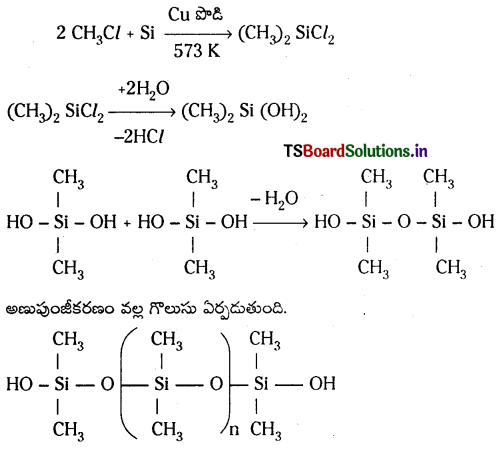
అణుపుంజీకరణం వల్ల గొలుసు ఏర్పడుతుంది.
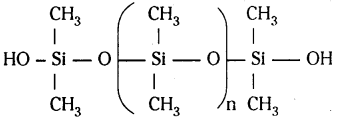
ఉపయోగాలు :
- వీటిని సీల్ వేసే పదార్థాలుగా, గ్రీజులుగా, విద్యుత్ బంధకాలుగాను
- బట్టలపై జలనిరోధకంగా ఉపయోగిస్తారు.
- శస్త్ర చికిత్స సంబంధమైన, సౌందర్య సాధన ద్రవ్యాల తయారీ పరిశ్రమలలో వాడతారు.
ప్రశ్న 40.
ఫుల్లరీన్ మీద సంక్షిప్తంగా వ్రాయండి.
జవాబు:
ఫుల్లరీన్ కార్బన్ స్ఫాటిక రూపాంతరం
తయారుచేయుట : జడవాయువులైన హీలియం లేదా ఆర్గాన్ల సమక్షంలో గ్రాఫైట్ను విద్యుచ్ఛాపంతో వేడి చేసిన ఫుల్లరీన్ తయారవుతుంది.
బాష్పీభవనం చెందిన Cn చిన్న అణువులు ఘనీభవించడం వల్ల వచ్చిన మసిలాంటి పదార్థంలో ముఖ్యంగా C60 తక్కువ పరిమాణంలో C70 ఉంటాయి. కార్బన్ పరమాణువులు 350 ఆ పైన ఫుల్లరిన్లు లేశమాత్రం ఉంటాయి.
ఫుల్లరీన్లు పంజరాన్ని పోలిన అణువులు. C60 అణువుకు సాకర్ బంతిని పోలిన నిర్మాణం ఉండటం వల్ల దీనిని బక్ మినిష్టర్ ఫుల్లరీన్ అంటారు. దీనిలో ఆరు కార్బన్లున్న వలయాలు ఇరవై, ఐదు కార్బన్లున్న వలయాలు పన్నెండు ఉంటాయి. ఆరు కార్బన్ల వలయం ఆరు కార్బన్ల వలయం లేదా అయిదు కార్బన్ల వలయంతో సంలీనం చెందుతాయి. కానీ అయిదు కార్బన్ల వలయాలు ఆరు కార్బన్ల వలయాలతో మాత్రమే సంలీనం చెందుతాయి. అన్ని కార్బన్లు sp2 సంకరీకరణం చెంది ఉంటాయి.
ప్రతి కార్బన్ ఆసన్న కార్బన్లతో మూడు సిగ్మా బంధాలను ఏర్పరుస్తుంది. మిగిలిన ఎలక్ట్రాన్ అణు ఆర్బిటాల్ తో అస్థానీకృతమయి అణువుకు ఎరోమాటిక్ స్వభావం చేకూరుస్తుంది. ఈ బంతి ఆకృతి గల అణువుకు 60 శీర్షాలు ఉన్నాయి. ప్రతి శీర్షంను ఒక కార్బన్ పరమాణువు ఆక్రమించి ఉంటుంది. ఈ కార్బన్లకు ఏక, ద్విబంధాలు రెండు ఉండి C – C బంధ దూరాలు 143.5 pm, 138.3 pm లు ఉంటాయి.

ప్రశ్న 41.
SiO2 నీటిలో ఎందుకు కరగదు ?
జవాబు:
సిలికాన్ డై ఆక్సెడ్ సమయోజనీయ, త్రిమితీయ అల్లిక గల ఘనం. ఇందులో సిలికాన్ పరమాణువు సమయోజనీయ బంధంతో టెట్రాహెడ్రల్ రీతిలో నాలుగు ఆక్సిజన్ పరమాణువులతో కలిసి ఉంటుంది.
సాధారణ స్థితిలో సిలికా దాదాపు చర్యాశీలత లేనిది. ఎందుకంటే Si – O బంధ ఎంథాల్పీ చాలా ఎక్కువ. అందువల్లనే అది నీటిలో కరగదు.
ప్రశ్న 42.
వజ్రం కఠినంగా ఎందుకు వుంటుంది ?
జవాబు:
డైమండ్ ప్రతి కార్బన్ sp3 సంకరీకరణం చెందుతుంది. ప్రతి కార్బన్ నాలుగు ఇతర కార్బన్ పరమాణువులతో sp3 సంకర ఆర్బిటాల్లను టెట్రా హెడ్రల్ రీతిలో ఉపయోగించుకొని బంధాలను ఏర్పరుస్తుంది. ఈ నిర్మాణం ప్రాదేశికంగా వ్యాపించి కార్బన్ పరమాణువులతో దృఢమైన త్రిమితీయ అల్లికను ఏర్పరుస్తుంది. ఇలా వ్యాపించి వున్న సమయోజనీయ బంధాలను విచ్ఛిన్నం చేయడం చాలా శక్తితో కూడుకున్న పని. అందువల్ల డైమండ్ (వజ్రం) కఠినమైనది.

ప్రశ్న 43.
కింది వాటిని వేడి చేసినపుడు ఏమి జరుగుతుంది ?
a) CaCO3
b) CaCO3, SiO2
c) CaCO3 అధికంగా కోక్
జవాబు:
a) కాల్షియం కార్బొనేటు విఘటనం చెంది CO2 విడుదలవుతుంది.
CaCO3 (ఘ) → CaO (ఘ) + CO2 (వా)
b) CaCO3 మరియు SiO2
CaCO3 విఘటనం చెందినపుడు ఏర్పడిన CaO తో SiO2 చర్యపొంది కాల్షియం సిలికేటు ఏర్పడుతుంది.
CaCO3 → CaO + CO2
CaO + SiO2 → CaSiO3
c) CaCO3 విఘటనం వల్ల ఏర్పడిన CaO తో కోక్ చర్య పొందుతుంది. కాల్షియం కార్బైడ్ ఏర్పడుతుంది.
CaCO3 → CaO + CO2

ప్రశ్న 44.
Na2CO3 ద్రావణాన్ని CO2 వాయువులో సంతృప్తం చేస్తే అవలంబనం అవుతుంది. ఎందువల్ల ?
జవాబు:
నీటిలో సోడియం బైకార్బొనేటు అల్పద్రావణీయత గలది. స్వల్పంగా కరుగుతుంది. దీనికి బై కార్బొనేటు అయాన్లు హైడ్రోజన్ బంధాల వల్ల పొలిమరీకరణం చెంది ఉంటుంది. Na2CO3 ద్రావణంలోని CO2 ను పంపితే అల్ప ద్రావణీయత కల సోడియం బై కార్బొనేటు ఏర్పడుతుంది. అందువల్ల NaHCO3 అవలంబనం చెందుతుంది.
Na2CO3 + H2O + CO2 → 2 NaHCO3
ప్రశ్న 45.
ఈ క్రింది చర్యలలో ఏమి జరుగుతుంది ?
a) తడిసున్నం ద్వారా CO2ను పంపడం
b) CaC2 ను N2 తో వేడిచేయడం
జవాబు:
a) తడిసున్నంలోనికి CO2 ను పంపితే నీటిలో కరగని CaCO3 ఏర్పడుతుంది. ద్రావణం పాలవలె మారుతుంది.
Ca(OH)2 + CO2 → CaCO3 + H2O + CO2
CO2 అధికంగా పంపితే కాల్షియం బైకార్బొనేటు ఏర్పడుతుంది. అందువల్ల CaCO3 కరుగుతుంది.
CaCO3 + H2O + CO2 → Ca(HCO3)2
Ca(HCO3)2 నీటిలో కరుగుతుంది.
b) వేడి చేసిన CaC2 మీదికి నైట్రోజన్ వాయువును పంపితే కాల్షియం సైనమైడ్ మరియు గ్రాఫైట్ల మిశ్రమం ఏర్పడుతుంది.
CaC2 + N2 → Ca CN2 + C
కాల్షియం సైనమైడ్, గ్రాఫైట్ల మిశ్రమాన్ని నైట్రోలిమ్ అంటారు.
ప్రశ్న 46.
గ్రూపు 14 లో కార్బన్ అసంగత స్వభావాన్ని గురించి వ్రాయండి.
జవాబు:
ఒక గ్రూపులోని మొదటి మూలకం మిగిలిన మూలకాల కంటే భిన్న ధర్మాలను చూపుతుంది. కార్బన్ కూడా గ్రూపులోని మిగిలిన మూలకాలతో పోలిస్తే భిన్నంగా ప్రవర్తిస్తుంది. దీనికి కారణం కార్బన్కు గల తక్కువ పరిమాణం, అధిక ఋణ విద్యుదాత్మకత, అధిక అయనీకరణ ఎంథాల్పీ, d – ఆర్బిటాళ్ళు లేకపోవటం.
- కార్బన్ ప్రకృతిలో స్వేచ్ఛా స్థితిలో లభిస్తుంది. మిగతా మూలకాలు ప్రకృతిలో స్వేచ్ఛా స్థితిలో దాదాపుగా దొరకవు.
- కార్బన్లో అందుబాటులో ఉండే d – ఆర్బిటాళ్ళు ఉండవు. మిగతా మూలకాలలో d – ఆర్బిటాళ్ళు అందుబాటులో ఉంటాయి.
- కార్బన్ అలోహం. దీని పరమాణు సైజు చాలా చిన్నది. అందువలన ఇది అధిక కోవలంటే స్వభావం ఉన్న సమ్మేళనాలను ఇస్తుంది.
- కార్బన్ కెటనేషన్ అనే విశిష్ట లక్షణం చూపిస్తుంది. ఈ లక్షణం కొంతవరకు సిలికాన్లో ఉంటుంది.
- కార్బన్ తన పరమాణువుల మధ్య బహు బంధాలను ఏర్పరచగలదు. అలాగే ఇతర మూలకాలతో కూడా బహు బంధాలను ఏర్పరచగలదు.
- కార్బన్ యొక్క హైడ్రైడ్లను హైడ్రోకార్బన్లు అంటారు. మిగిలిన మూలకాలు కూడా హైడ్రైడ్లను ఇస్తాయి. ఈ హైడ్రైడ్ స్థిరత్వం క్రమంగా తగ్గుతుంది.
- కార్బన్ క్షయకరణ సామర్థ్యం చాలా ఎక్కువ. మిగిలిన మూలకాల క్షయకరణ సామర్థ్యం తక్కువ.
- కార్బన్ – హాలోజన్ సమ్మేళనాలు జల విశ్లేషణం చెందవు. కాని మిగతా మూలకాలు టెట్రాహాలైడ్లు తేలిగ్గా జలవిశేషణం చెందుతాయి.
దీర్ఘ సమాధాన ప్రశ్నలు
ప్రశ్న 47.
సిలికోన్లు అంటే ఏమిటి ? వాటిని ఏ విధంగా తయారుచేస్తారు ? ఉదాహరణ ఇవ్వండి.
జవాబు:
సిలికోన్లు ఆర్గానో సిలికాన్ సమ్మేళనాలు. వీటిలో సిలికాన్కు ఆక్సిజన్, కార్బన్లు బలంగా బంధింపబడి ఉంటాయి. వీటి నిర్మాణాత్మక ఫార్ములా క్రింది విధంగా ఉంటుంది.

573 K వద్ద కాపర్ ఉత్ప్రేరకం సమక్షంలో మిథైల్ క్లోరైడును సిలికాన్ పైకి పంపితే అనేక రకాలైన మిథైల్ ప్రతిక్షేపిత క్లోరోసిలేనులు, ఏర్పడతాయి.
డై మిథైల్ డైక్లోరోసిలేన్ (CH3)2 SiCl2 జల విశ్లేషణ చెందగా ఏర్పడిన ఉత్పన్నాలు సంఘనన అణుపుంజీకరణం చెంది పొడవైన గొలుసుల అణుపుంజాలు ఇస్తాయి.
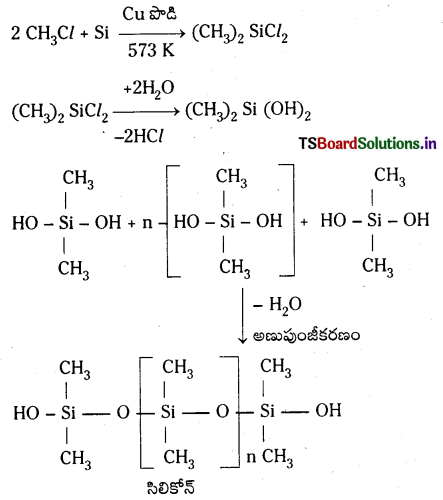
పొలిమర్ శృంఖలం పొడవును (CH3)3 SiCl ను కలిపి నియంత్రించవచ్చు.

ధర్మాలు :
అధ్రువ ఆల్కెల్ సమూహాలతో చుట్టుకొన్న సిలికోన్లు జలవికర్షణ స్వభావం ఉన్నవి.
వీటికి అధిక ఉష్ణ స్థిరత్వం కలదు. ఆక్సీకరణం, ఇతర రసాయన చర్యలను నిరోధిస్తాయి.
ఉపయోగాలు :
- సిలికోన్ రబ్బర్లు తయారీలో వాడతారు.
- వాటర్ ఫ్రూఫ్ బట్టలు, కాగితాలు తయారుచేయడానికి వాడతారు.
- విమానాలలో కందెనలుగాను, గ్రీజు తయారీలోను వాడతారు.
- వీటికి రసాయన జడత్వం ఉన్నది. అందువలన అధిక ఉష్ణోగ్రతలను తట్టుకొంటాయి. కనుక పెయింటులలోను, పింగాణీలలోను ఉపయోగిస్తారు.
- సీలు వేసే పదార్థాలుగా
- విద్యుత్ బంధకాలుగా ఉపయోగిస్తారు.
- -40°C వద్ద కూడా గడ్డ కట్టవు. అందువలన విమానాలలో కందెనగా ఉపయోగిస్తారు.

ప్రశ్న 48.
సిలికా నిర్మాణాన్ని వివరించండి. అది
a) NaOH
b) HF తో ఏ విధంగా చర్య జరుపుతుంది ?
జవాబు:
సిలికాన్ డై ఆక్సైడ్ను సాధారణంగా సిలికా అంటారు. ఇది అనేక స్ఫాటిక రూపాలలో దొరుకుతుంది. క్వార్ట్జ్, క్రిస్టో బలైట్, ట్రిడిమైట్లు సిలికా యొక్క కొన్ని స్ఫటికాకారాలు. సిలికాన్ ఆక్సైడ్ సమయోజనీయ, త్రిమితీయ అల్లికగన ఘనం.
సిలికాన్ నిర్మాణం : సిలికాలో ప్రతి సిలికాన్ పరమాణువు నాలుగు ఆక్సిజన్ పరమాణువులతో ఏక సమయోజనీయ బంధంతో చతుర్ముఖీయంగా అమర్చబడి ఉంటుంది. ప్రతి ఆక్సిజన్ పరమాణువు రెండు సిలికాన్ పరమాణువుల మధ్య బంధింపబడి ఉంటుంది. ఈ విధంగా SiO2 బలమైన త్రిజ్యామితీయ బృహదణు నిర్మాణం కలిగి ఉంటుంది. సాధారణ స్థితిలో సిలికా దాదాపు చర్యాశీలత లేనిది. ఎందుకంటే Si – O బంధ ఎంథాల్ఫీ చాలా ఎక్కువ.
a) NaOH తో చర్య జరిపి సోడియం సిలికేటును ఏర్పరుస్తుంది.
SiO2 + 2 NaOH → Na2 SiO3 + H2O
b) HF తో చర్య జరిపి SiF4 ను ఏర్పరుస్తుంది.
SiO2 + 4 HF → SiF4 + 2H2O
ప్రశ్న 49.
కార్బన్ రూపాంతరాలపై వివరణ వ్రాయండి.
జవాబు:
కార్బన్ భిన్న రూపాలలో లభిస్తుంది. అవి స్పటిక, అస్ఫాటిక రూపాలు.
స్ఫాటిక రూపాలు : డైమండ్, గ్రాఫైట్, ఫుల్లరీన్
అస్ఫాటిక రూపాలు : కోక్, కోల్ మొదలైనవి.
డైమండ్ మరియు గ్రాఫైట్లు కార్బన్ యొక్క స్ఫటిక రూపాంతరాలు. డైమండ్ త్రిజ్యామితీయ బృహదణు నిర్మాణం కలిగి ఉంటుంది.
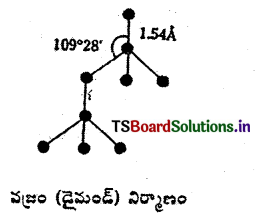
వజ్రం (డైమండ్) నిర్మాణం : వజ్రంలో ప్రతికార్బన్ పరమాణువు sp3 సంకరీకరణాన్ని పొందుతుంది. దానివలన ప్రతి కార్బన్ పరమాణువు మీద నాలుగు sp3 సంకర ఆర్బిటాళ్ళు ఏర్పడతాయి. ప్రతి కార్బన్ పరమాణువులోని నాలుగు sp3 సంకర ఆర్బిటాళ్ళు నాలుగు ఇతర కార్బన్ పరమాణువులతో బంధాలను ఏర్పరచుకుంటాయి. ప్రతి కార్బన్ పరమాణువు చతుర్ముఖీయ సౌష్ఠవాన్ని కలిగి ఉంటుంది. ఈ విధంగా కార్బన్ పరమాణువులు ఒకదానితో ఒకటి బంధింపబడి ఉండటం వలన పెద్ద అణువు ఏర్పడుతుంది.
దీనిలో C – C బంధదూరం 1.54 Ä, బంఢకోణం 190°28′
ఉపయోగాలు :
- ఆభరణాలలో విలువైన రాళ్ళుగా ఉపయోగిస్తారు.
- పాలరాయిని కోయడానికి ఉపయోగిస్తారు.
- టంగ్స్టన్ వంటి లోహాల నుండి అతి సన్నని తీగను తీయుటకు వాడతారు.
గ్రాఫైట్ నిర్మాణము : గ్రాఫైట్ ద్విజ్యామితీయ పొరల నిర్మాణాన్ని కల్గి ఉంటుంది. ఈ నిర్మాణం కార్బన్ పరమాణువులతో కూడిన షడ్భుజాకార వలయాలను కల్గి ఉంటుంది. గ్రాఫైట్లో ప్రతి కార్బన్ పరమాణువు sp2 సంకరీకరణాన్ని పొంది, మూడు ఇతర కార్బన్ పరమాణువులతో షడ్భుజాకార వలయాలుగా బంధించబడి ఉంటాయి. ఇటువంటి అనేక వలయాలు కలిసి ఒకే తలంలో ఉంటాయి. ఒంటరి ఎలక్ట్రాలు గల p ఆర్బిటాల్ ఈ తలానికి లంబంగా ఉంటుంది. ఈ p ఆర్బిటాళ్ళు ఒకదానితో ఒకటి కలిసిపోయి షడ్భుజాకార తలానికి పైన, క్రింద విస్తరించి ఉంటాయి. ఈ వలయాకారాలు ఒకదానిపై ఒకటి బలహీనమైన వాండర్వాల్ బలాలచే బంధించబడి ఉంటాయి. దీనిలో C – C బంధదూరం 1.42 రెండు వలయాల మధ్య దూరం 3.4 .
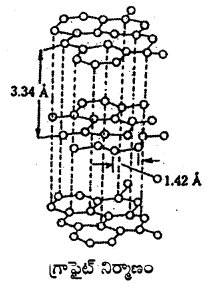
ఉపయోగాలు :
- కందెనగా ఉపయోగిస్తారు.
- లెడ్ పెన్సిళ్ళ తయారీలో ఉపయోగిస్తారు.
- గ్రాఫైట్ ఉత్తమ విద్యుద్వాహకము. అందువల్ల ఎలక్ట్రోడ్ల తయారీలో ఉపయోగిస్తారు.
ఫుల్లరీన్ : ఫుల్లరీన్ కార్బన్ స్పాటిక రూపాంతరం
తయారుచేయుట : జడవాయువులైన హీలియం లేదా ఆర్గాన్ల సమక్షంలో గ్రాఫైట్ను విద్యుచ్ఛాపంతో వేడి చేసిన ఫుల్లరీన్ తయారవుతుంది.
బాష్పీభవనం చెందిన Cn చిన్న అణువులు ఘనీభవించడం వల్ల వచ్చిన మసిలాంటి పదార్థంలో ముఖ్యంగా C60, తక్కువ పరిమాణంలో C70 ఉంటాయి. కార్బన్ పరమాణువులు 350 ఆ పైన పుల్లరిన్లు లేశమాత్రం ఉంటాయి.
ఫుల్లరీన్లు పంజరాన్ని పోలిన అణువులు. C60 అణువుకు సాకర్ బంతిని పోలిన నిర్మాణం ఉండటం వల్ల దీనిని బక్ మినిష్టర్ ఫుల్లరీన్ అంటారు. దీనిలో ఆరు కార్బన్లున్న వలయాలు ఇరవై, ఐదు కార్బన్లున్న వలయాలు పన్నెండు ఉంటాయి. .ఆరు కార్బన్ల వలయం ఆరు కార్బన్ల వలయం లేదా అయిదు కార్బన్ల వలయంతో సంలీనం చెందుతాయి. కానీ అయిదు కార్బన్ల వలయాలు ఆరు కార్బన్ల వలయాలతో మాత్రమే సంలీనం చెందుతాయి. అన్ని కార్బన్లు sp2 సంకరీకరణం చెంది ఉంటాయి.
ప్రతి కార్బన్ ఆసన్న కార్బన్లతో మూడు సిగ్మా బంధాలను ఏర్పరుస్తుంది. మిగిలిన ఎలక్ట్రాన్ ఆర్బిటాల్లతో అస్థానీకృతమయి అణువుకు ఎరోమాటిక్ స్వభావం చేకూరుస్తుంది. ఈ బంతి ఆకృతి గల అణువుకు 60 శీర్షాలు ఉన్నాయి. ప్రతి శీర్షంను ఒక కార్బన్ పరమాణువు ఆక్రమించి ఉంటుంది. ఈ కార్బన్లకు ఏక, ద్విబంధాలు రెండు ఉండి C – C బంధ దూరాలు 143.5 pm, 138.3 pm లు ఉంటాయి.
అస్ఫాటిక రూపాంతరాలు :
కోల్ : భూమిలో కొన్ని శతాబ్దాల క్రితం మట్టితో కప్పబడిపోయిన వృక్ష సంబంధమైన పదార్థాలు ఆక్సిజన్ సమక్షంలో అధిక పీడనం, ఉష్ణోగ్రతల వద్ద కృశించిపోయినపుడు కోల్ ఏర్పడుతుంది. కోల్లో కార్బన్, హైడ్రోజన్, ఆక్సిజన్, నైట్రోజన్ ఉంటాయి. 60% కార్బన్ ఉన్న కోలన్ను పీట్ అని 70% కార్బన్ ఉన్న కోల్న లిగ్నైట్ అని, 78% బిట్యూ మినస్ అని, 83% సెమి బిట్యూమినస్ కోల్, 90% కార్బన్ ఉన్నదాన్ని ఆంధ్ర సైట్ అని అంటారు.
కోక్ : కోల్న ఆక్సిజన్ లేని వాతావరణంలో విధ్వంసక స్వేదనం చర్యకు గురి చేసినపుడు భాష్పశీలి పదార్థాలయిన కోల్స్, అమ్మోనియా, బెంజీన్ లు ఏర్పడతాయి. మిగిలిన అవశేషాన్నే కోక్ అంటారు.
ఉపయోగాలు :
- కోల్ను ఇంధనంగా వాడతారు.
- కృత్రిమ పెట్రోలు తయారీలో వాడతారు.
- కోకను స్టీలు పరిశ్రమలో క్షయకారిణిగా వాడతారు.
- గ్రాఫైట్ను, వాటర్ సన్ను తయారుచేయడానికి వాడతారు.
ప్రశ్న 50.
కిందివాటిపై వివరణ వ్రాయండి.
ఎ) సిలికేట్లు
బి) జియోలైట్లు
సి) పుల్లరీన్లు
జవాబు:
ఎ) సిలికేట్లు : సిలికేట్ల మూల నిర్మాణాత్మక యూనిట్ Si\(\mathrm{O}_4^{4-}\). ఇందులో సిలికాన్ పరమాణువు నాలుగు ఆక్సిజన్ పరమాణువులతో టెట్రాహెడ్రల్ రీతిలో బంధంలో కలిసి ఉంటాయి. సిలికేట్లలో ఆక్సిజన్ పరమాణువులను ఇతర యూనిట్లతో పంచుకోవడం ద్వారా శృంఖల, వలయ, షీట్ లేదా త్రిమితీయ నిర్మాణాలు ఏర్పడవచ్చు.
సిలికేట్ యూనిట్లలో రుణావేశం ధనావేశం గల లోహ అయానులతో తటస్థీకరించబడుతుంది. ఒకవేళ, యూనిట్ యొక్క నాలుగు మూలలు ఇతర టెట్రాహెడ్రల్ యూనిట్లతో పంచుకుంటే త్రిమితీయ అల్లిక నిర్మాణాన్ని పొందుతుంది.

బి) జియోలైట్లు : అల్యూమినియం సిలికేటులను జియొలైట్లు అంటారు. త్రిమితీయంగా అల్లిక గల సిలికాన్ డై ఆక్సైడ్ కొన్ని సిలికాన్ పరమాణువులను అల్యూమినియం పరమాణువులు స్థానభ్రంశం చేస్తే అల్యూమినియం సిలికేట్లు ఏర్పడతాయి. దీనికి రుణావేశం ఉంటుంది. Na+, K+ లేదా Ca++ కేటయాన్లు రుణావేశాన్ని తుల్యం చేస్తాయి.
ఉదా : ఫెల్డ్ స్పార్ జియొలైటులు. పెట్రో కెమికల్ పరిశ్రమల్లో హైడ్రోకార్బన్లను భంజనం చేయడానికి, వాటి సాదృశీకరణ చర్యలకు జియొలైట్లను ఉత్ప్రేరకాలుగా విస్తృతంగా వాడతారు. ఉదా : ZSM – 5 ఆల్కహాల్లను నేరుగా గాసోలీన్ మార్చడానికి ఉపయోగిస్తారు. కఠినజలం కఠినత్వాన్ని తగ్గించడానికి ఆర్ద్ర జియొలైట్లను అయాన్ వినిమయాలుగా ఉపయోగిస్తారు.
సి) ఫుల్లరీన్లు : ఫుల్లరీన్ కార్బన్ స్పాటిక రూపాంతరం
తయారుచేయుట : జడవాయువులైన హీలియం లేదా ఆర్గాన్ల సమక్షంలో గ్రాఫైట్ను విద్యుచ్ఛాపంతో వేడి చేసిన ఫుల్లరీన్ తయారవుతుంది.
బాష్పీభవనం చెందిన Cn చిన్న అణువులు ఘనీభవించడం వల్ల వచ్చిన మసిలాంటి పదార్థంలో ముఖ్యంగా C60. తక్కువ పరిమాణంలో C70 ఉంటాయి. కార్బన్ పరమాణువులు 350 ఆ పైన పుల్లరిన్లు లేశమాత్రం ఉంటాయి.
ఫుల్లరీన్ లు పంజరాన్ని పోలిన అణువులు. C60 అణువుకు సాకర్ బంతిని పోలిన నిర్మాణం ఉండటం వల్ల దీనిని బక్ మినిష్టర్ ఫుల్లరీన్ అంటారు. దీనిలో ఆరు కార్బన్లున్న వలయాలు ఇరవై, ఐదు కార్బన్లున్న వలయాలు పన్నెండు ఉంటాయి. ఆరు కార్బన్ల వలయం. ఆరు కార్బన్ల వలయం లేదా అయిదు కార్బన్ల వలయంతో సంలీనం చెందుతాయి. కానీ అయిదు కార్బన్ల వలయాలు ఆరు కార్బన్ల వలయాలతో మాత్రమే సంలీనం చెందుతాయి. అన్ని కార్బన్లు sp2 సంకరీకరణం చెంది ఉంటాయి.
ప్రతి కార్బన్ ఆసన్న కార్బన్లతో మూడు సిగ్మా బంధాలను ఏర్పరుస్తుంది. మిగిలిన ఎలక్ట్రాన్ అణు ఆర్బిటాల్లతో అస్థానీకృతమయి అణువుకు ఎరోమాటిక్ స్వభావం చేకూరుస్తుంది. ఈ బంతి ఆకృతి గల అణువుకు 60 శీర్షాలు ఉన్నాయి. ప్రతి శీర్షంను ఒక కార్బన్ పరమాణువు ఆక్రమించి ఉంటుంది. ఈ కార్బన్లకు ఏక, ద్విబంధాలు రెండు ఉండి C – C బంధ దూరాలు 143.5 pm, 138.3 pm లు ఉంటాయి.
అదనపు పశ్నలు
ప్రశ్న 1.
14వ గ్రూపు మూలకాలలో
1) అధిక ఆమ్ల డై ఆక్సెడును ఏర్పరచేది
2) సాధారణంగా +2 ఆక్సీకరణ స్థితిలో ఏర్పడేది.
3) అర్థవాహక ఉపకరణాలలో ఉపయోగపడేది
జవాబు:
1) కార్బన్
2) లెడ్
3) సిలికాన్, జెర్మేనియం
ప్రశ్న 2.
డైమండ్ సమయోజనీయ స్వభావం కలది. అయినప్పటికి అధిక ద్రవీభవన ఉష్ణోగ్రత ఎందుకు ?
జవాబు:
ధృఢమైన C – C బంధాల అల్లికతో ఉన్న త్రిమితీయ నిర్మాణం డైమండ్కు ఉంటుంది. దృఢమైన C – C బంధాలను విచ్ఛిన్నం చేయడానికి చాలా శక్తి కావాలి. అందువల్ల దీని ద్రవీభవన ఉష్ణోగ్రత చాలా అధికం.
ప్రశ్న 3.
కార్బన్ మోనాక్సైడ్ నిర్మాణం వ్రాయండి.
జవాబు:
CO అణువులో ఒక సిగ్మా, రెండు π బంధాలు కార్బన్ ఆక్సిజన్ల మధ్య గలవు. :C ≡ O: కార్బన్ పై ఒంటరి ఎలక్ట్రాన్ ఉండుటవలన CO అణువు ఎలక్ట్రాన్ జంట దాతగా పనిచేస్తుంది.
ప్రశ్న 4.
IV A గ్రూపులో రూపాంతరతను చూపించని మూలకం ఏది ?
జవాబు:
లెడ్
ప్రశ్న 5.
కార్బన్ మోనాక్సైడ్ యొక్క అనువర్తనాలను రాయండి.
జవాబు:
- వాటర్స్, ప్రొడ్యూసర్గాస్, కోల్గాస్ల వంటి వాయు ఇంధనాలలో CO ముఖ్యమైన అనుఘటకం.
- అనేక లోహ ఆక్సైడ్లను క్షయకరణం చెందించి లోహాలుగా మారుస్తుంది.
- మాండ్ పద్ధతిలో Ni నిష్కర్షణలో CO ని లైగాండ్గా వాడతారు.
ప్రశ్న 6.
కార్బన్ డై ఆక్సైడ్ యొక్క అనువర్తనాలను రాయండి.
జవాబు:
- ఘనస్థితిలో ఉన్న CO2 ను డ్రై ఐస్ అంటారు. దీనిని ప్రశీతకంగా వాడతారు.
- ప్రయోగశాలలో శీతలీకరణిగా వాడతారు.
- యూరియాను తయారుచేయడానికి, జడవాతావరణాన్ని ఏర్పరచడానికి, క్షారాలను తటస్థీకరించడానికి వాడతారు.
- అగ్నిమాపక యంత్రాలలో వాడతారు.
ప్రశ్న 7.
CO2, SiO2 ధర్మాలలో భేదాలు వ్రాయండి.
జవాబు:
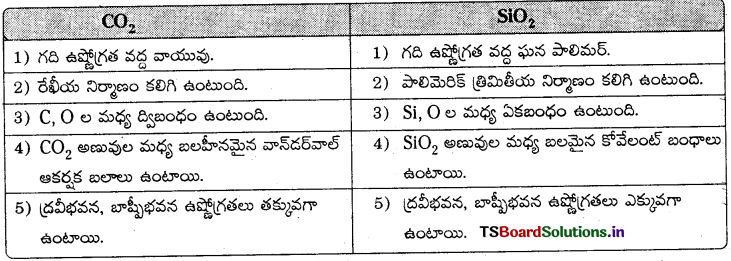
ప్రశ్న 8.
కార్బన్, సిలికాన్ల మధ్య గల పోలికలను రాయండి.
జవాబు:

ప్రశ్న 9.
పెన్సిళ్ళ తయారీలో కార్బన్ యొక్క ఏ రూపాంతరాన్ని వాడతారు ?
జవాబు:
గ్రాఫైట్ను పెన్సిళ్ళ తయారీలో వాడతారు.
ప్రశ్న 10.
లెడ్ యొక్క స్థిర ఆక్సీకరణ స్థితి ఏది ? కారణం ఏమిటి ?
జవాబు:
లెడ్ యొక్క స్థిర ఆక్సీకరణ స్థితి + 2 (జడ ఎలక్ట్రాన్ +4 ఆక్సీకరణ స్థితి అస్థిరమైనది. జంట ప్రభావం వల్ల చూపదు)
ప్రశ్న 11.
కార్బొరండం అనగా ఏమి ? ఇది ఎలా ఏర్పడుతుంది ?
జవాబు:
సిలికాన్ కార్బెడు కార్బొరండం అంటారు. విద్యుత్ కొలిమిలో సిలికాన్, కార్బన్లను కలిపి వేడి చేయడం ద్వారా దీనిని తయారుచేస్తారు.

ప్రశ్న 12.
గ్రాఫైట్లో రెండు పొరల మధ్య దూరం ఎంత ? కారణం ఏమిటి ?
జవాబు:
గ్రాఫైట్లో రెండు పొరల మధ్య దూరం 3.35. గ్రాఫైట్ పొరల మధ్య బలహీన వాన్ డర్ వాల్ బలాలు ఉండటం వల్ల పొరల మధ్య దూరం ఎక్కువగా ఉంటుంది.
ప్రశ్న 13.
CO2మరియు SiO2 లలో ఉండే సంకరీకరణాలు ఏమిటి ?
జవాబు:
CO2 లో sp సంకరీకరణం ఉంటుంది. SiO2 లో sp3 సంకరీకరణం ఉంటుంది.
ప్రశ్న 14.
డైమండ్ కఠినంగా ఉండగా గ్రాఫైట్ మృదువుగా ఉంటుంది. ఎందువలన ?
జవాబు:
డైమండ్కు బృహదణు నిర్మాణం ఉంటుంది. అందువలన అది కఠినంగా ఉంటుంది. గ్రాఫైట్లో పొరల నిర్మాణం ఉంటుంది. అందువలన అది మృదువుగా ఉంటుంది.
ప్రశ్న 15.
సిలికా ఫార్ములా SiO2 గా ఎందుకు ఉంటుంది ?
జవాబు:
Si సిలికా నిర్మాణంలో ప్రతి టెట్రాహెడ్రన్ మూలమీద ఉన్న ఆక్సిజన్ను రెండు సిలికాన్ పరమాణువులు పంచుకుంటాయి. ప్రతి సిలికాన్ పరమాణువు శీర్షం వద్ద ఆక్సిజన్లో అర్ధ భాగాన్ని మాత్రమే ప్రదానం చేస్తుంది అన్నమాట. అందువలననే సిలికా ఫార్ములా SiO2 అవుతుంది.
ప్రశ్న 16.
క్వార్ట్జ్ అంటే ఏమిటి ?
జవాబు:
పరిశుద్ధ సిలికాను క్వార్ట్జ్ అంటారు.
ప్రశ్న 17.
ఆర్థో సిలికేట్స్, పైరో సిలికేట్స్ మరియు చైన్ సిలికేట్స్లోలో గల యూనిట్లను తెలపండి.
జవాబు:
ఆర్థో సిలికేట్లు : Si\(\mathrm{O}_4^{-4}\) యూనిట్లు
పైరో సిలికేట్లు : SiO-6 యూనిట్లు
చైన్ సిలికేట్లు : \(\mathrm{O}_3^{-4}\) యూనిట్లు
![]()
![]()
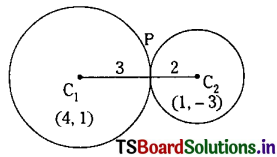
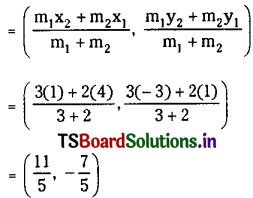
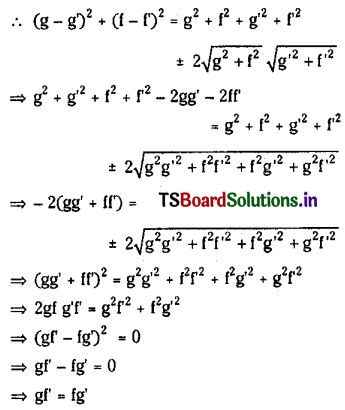
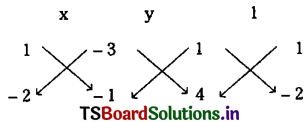
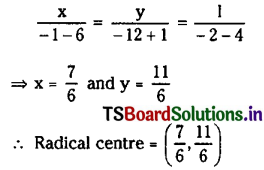

![]()
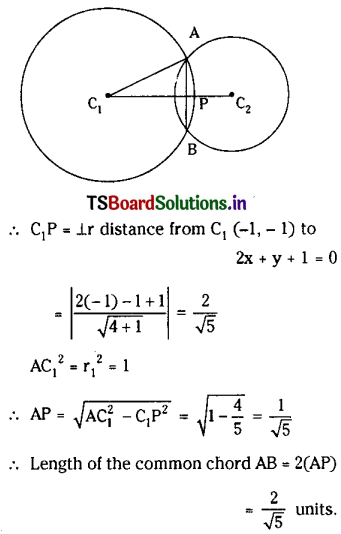

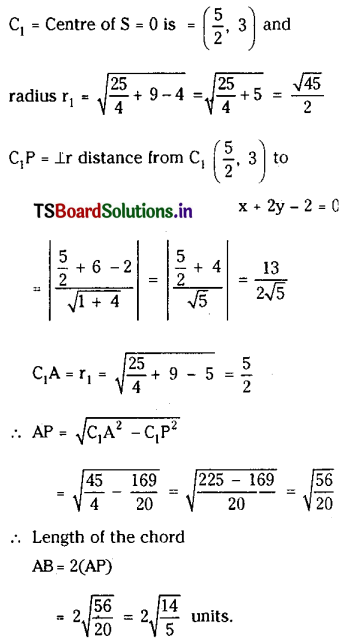

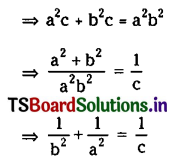
![]()
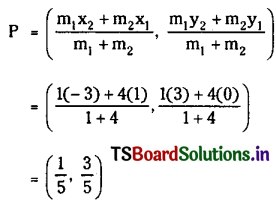
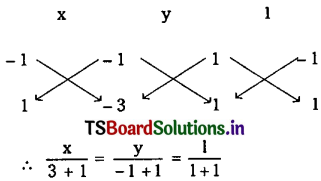
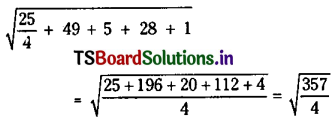
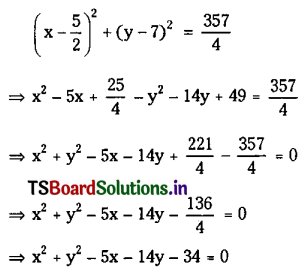
![]()

